70+ Unique Japan Bucket List Activites To Check-Off

If you’re looking for the best things to do in Japan, don’t tell me because I am about to be jealous of you. After traveling through 80+ countries, I’ve concluded that Japan is my absolute favorite country to visit. The culture, cuisine, historical sites, and nature make it an extraordinarily fascinating place to explore and a wealth of possibilities.
There are so many unique things to do in Japan that it was hard to narrow this list down to just 30! I’ve tried to mix up the items listed across all different prefectures, so there is something that everyone can enjoy in the Land of the Rising Sun. If you want to get the most out of what Japan offers, I recommend spending at least two weeks in the country, although you could spend ten years checking off your Japan bucket list!
The Ultimate Japan Bucket List
Make A Pilgrimage Along the Kumano Kodo

The Kumano Kodo has been a pilgrimage destination in Japan for over millennia. The collection of shrines, temples, and trails remains the nation’s spiritual heart. People from all levels of society made the pilgrimage using a network of routes across the Kii Peninsula. Emperors, artisans, aristocrats, and even peasants traveled for over 30 days from hubs like Osaka and Kyoto.
Those paths are the Kumano Kodo, which many still walk today. Since it was a network of trails, there was no one set trail. The Kumano Kodo is a maze of trails that travel up and down ridges, along the coast, and through old Japanese forests full of cypress and cedar trees. Around 3000 shrines and many amazing sites are scattered across the ancient network.
Now, pilgrims and travelers come from around the world to enjoy the spirituality and tranquility of these old mountains, trails, forests, and shrines. The trail is not a camping experience, and although there are a few campsites, most pilgrims stay in guesthouses and ryokans. It is similar to the Camino De Santiago in many ways, and accommodation often comes with dinner and breakfast with the option of a packed lunch.
The Kumano Kodo trail network is in the Kii Mountain range of Japan. They are easily accessible from the towns of Kii-Katsura, Tanabe, and Shingu. Most of the trail network lies in Wakayama Prefecture but extends into parts of the Mie and Nara Prefectures.
Take A Ride On a Bullet Train
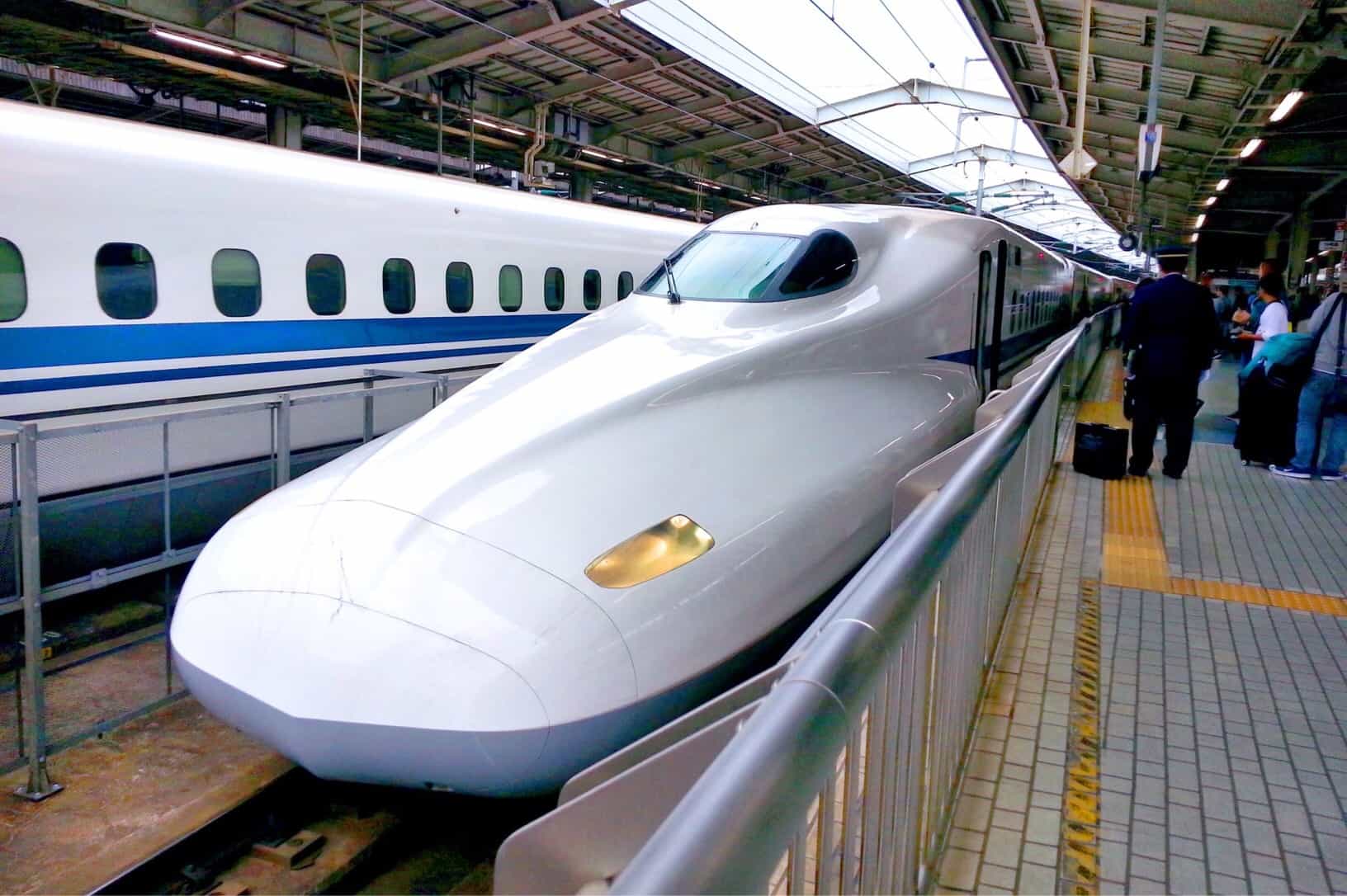
Riding a bullet train should be on everyone’s Japan bucket list. With thousands of miles of track and speeds nearing 200 miles per hour, riding the bullet train—or Shinkansen—is one of those things to do in Japan that you really should take advantage of. Be warned: After riding one of these technological masterpieces, you’ll never be content with Amtrak again.
Since its beginning four decades ago, the trains have carried billions of passengers; until recently, they held the world title for most passengers on non-traditional trains, and the Chinese high-speed train network surpassed them.
If you plan to travel extensively around Japan, you’ll save a lot of money by investing in a JR Pass before arriving. To simplify things, 7, 14, and 21-day passes are available; depending on where you plan to go, you may choose a national pass or one of the many available regional passes.
Attend a Sumo Tournament

Sumo is a form of competitive wrestling that originated in Japan. You may have seen sumo suits at parties before, but I assure you that Sumo is a real sport in Japan with professional wrestlers. One of the best things to do in Japan for excitement and culture is to attend a professional sumo wrestling tournament.
In Tokyo, I went to the sumo hall of Ryōgoku and had a great time watching the games. You can also find sumo halls in Osaka, Nagoya, and Fukuoka. Check the Japan Sumo Association to see if there’s a tournament going on while you’re visiting Japan.
Soak in an Onsen or Sento


Visiting a Japanese onsen or sento is a quintessential experience! An onsen is a Japanese hot spring where visitors are separated by sex and can soak naked in the warm water, usually outside. Its roots trace back to the original forms of bathing for the Japanese, and it has long been prized for its therapeutic benefits.
The experience is incredibly relaxing, especially during the winter months. Japan has been blessed with abundant natural hot springs and geothermal water. As a result, thousands of onsens are scattered throughout the country, and they are a facet of Japanese life. So, a visit to an onsen is a tremendous way to gain a better understanding of Japanese culture.
Don’t be shy! Everyone in an onsen is naked, and no one cares. You may not wear a bathing suit in an onsen, and some traditional onsens even ban tattoos, so check accordingly if you have tattoos. Onsens are separated by sex, and you are required to wash your body before entering. Many times, you will also wash afterward to remove the minerals.
Cat Cafe it Up

Cat cafes are very popular in Japan. Many Japanese cannot have animals at home, as most live in apartments. Instead, they can visit a clean cafe, where being around pets can stimulate positivity and relaxation.
There are plenty of cat cafes in Tokyo, although cat cafes are popular in most major Japanese cities. Cat cafes typically cost ¥500-1000 to enter. Once in, you can enjoy the presence of the cats, but I’ve never been in one where you can hold a cat or that sells coffee and treats like the name “cafe” implies. If you are traveling as a family, try heading to a cat cafe!
Enjoy the Astounding Culinary Scene



Japan is a land of amazing cuisine, and visitors should make it a point to try as many dishes as they can. My favorite place to grab a bite to eat is a conveyor belt sushi restaurant, which serves cheap but good-quality sushi. Other great dishes are ramen, okonomiyaki, Genghis Khan, yakitori, soba, and udon. Yum! Another classic is a kaiseki meal, pictured above, consisting of various small dishes—often very simple and delicious.
The best part about eating in Japan is it’s affordable. We could easily go to a decent restaurant and leave full for under ¥3000. Note that it is not customary to tip in Japan, and doing so might be seen as disrespectful. We have an article on all the Japanese dishes you should try when visiting the country.
Revel In Sakura

Most people who want to visit Japan have this on their bucket list. The cherry blossom, or Sakura in Japanese, is perhaps one of Japan’s most remarkable times of year. Every spring, the blossoming of Sakura and pleasant weather draw travelers from around the world.
Thanks to its incredible cultural sites, Kyoto is a top destination for tourists and Japanese alike to view cherry blossoms. The city’s parks, greenways, shrines, and historic districts are lined with cherry trees, and they wash over the city in a sea of pink. There’s little doubt that it makes for one of the most beautiful cities in the world.
Hit Up an Arcade
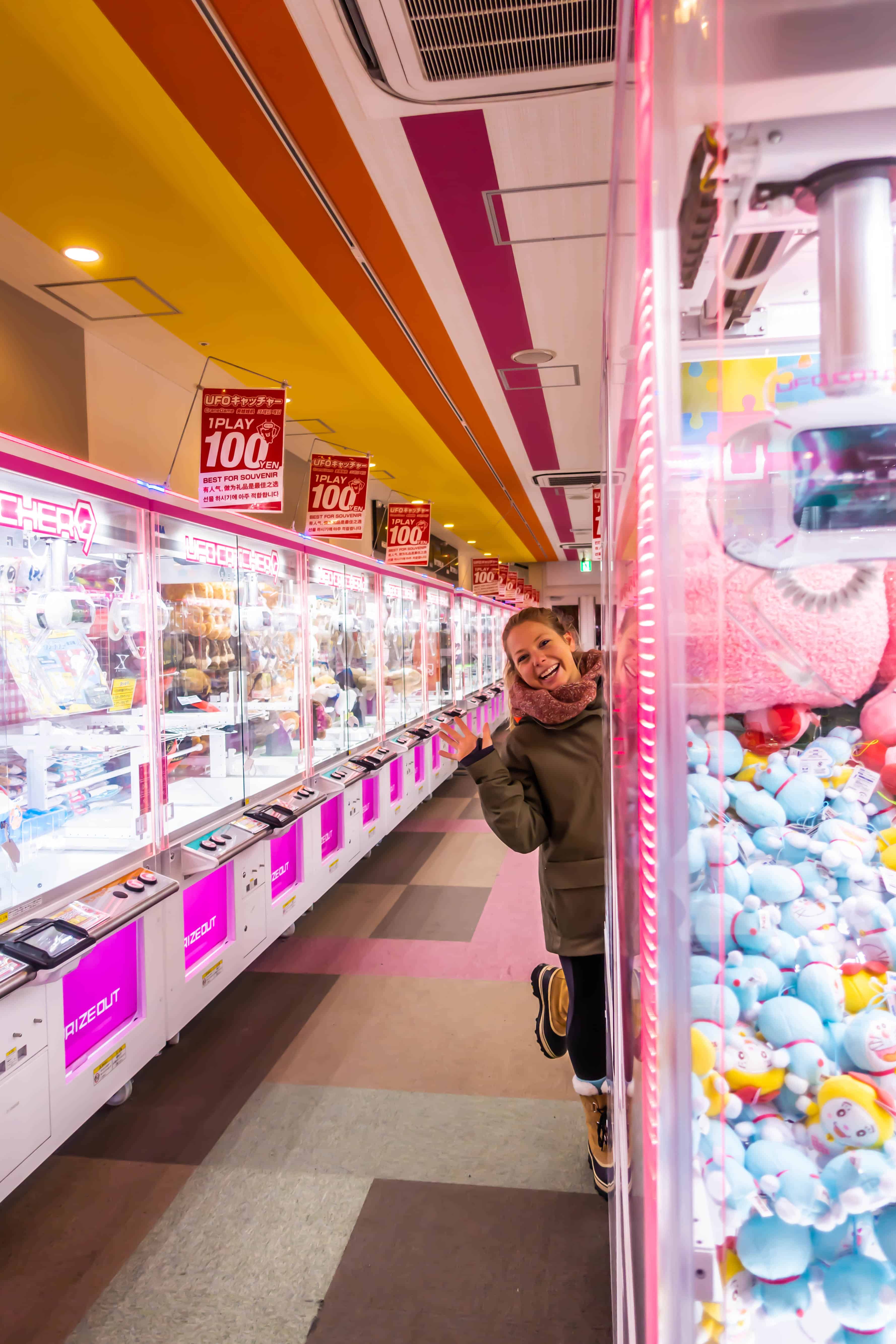

Arcades are everywhere in Japan, and there are plenty to keep you entertained in the cities. If you’re in the mood for loud noises, bright lights, and lots of virtual fun, heading to the arcade is a blast. You can play games with your friends, dress up, or use “the claw” to score a stuffed animal. The options are endless.
Enjoy a Traditional Japanese Tea Ceremony

The Japanese tea ceremony is a traditional cultural activity involving matcha tea’s preparation and beautiful presentation. It’s unique to Japan and will teach visitors a lot about Japanese culture. The tea ceremony represents respect, harmony, purity, and tranquility, and as visitors, you can learn the basic concepts and ideas of a tea ceremony. The providers will demonstrate “the way of tea” in a quiet atmosphere and allow you to make your matcha tea with Japanese cake!
Sake Tasting
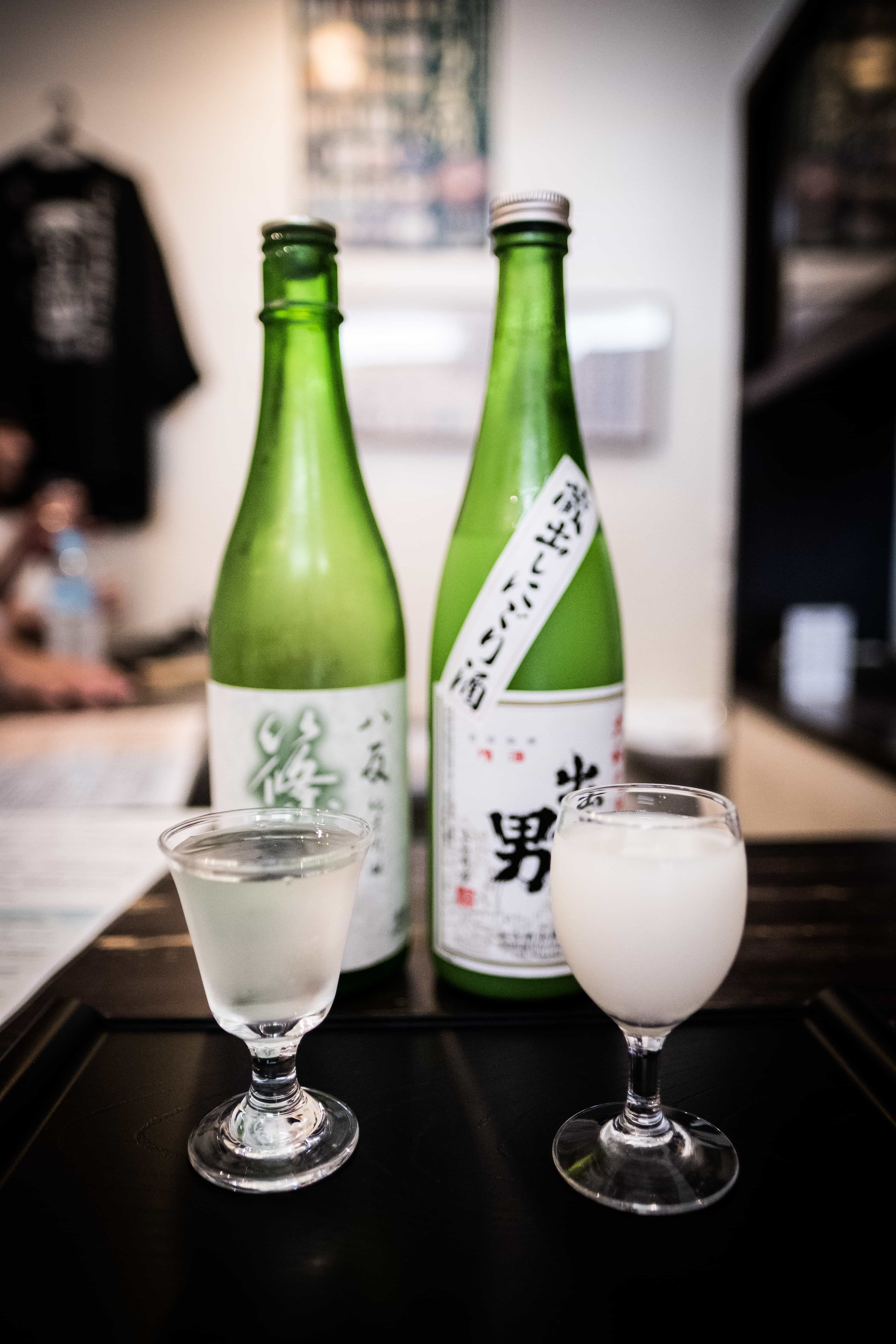
Have you had enough of city sightseeing? One of my favorite things to do when I get to Japan is visit a sake bar. Sake is a Japanese rice wine served chilled, at room temperature, or warm. I love warm sake in the winter and chilled sake in the summer. There are plenty of sake bars around Japan to pop into for a few glasses of Japanese sake. My favorites are JAM + SAKE Bar and Sake Bar Yoramu in Kyoto!
Things to do in Kyoto
Arashiyama Bamboo Forest

The Arashiyama Bamboo Forest is easily one of the best places in Japan to visit. Lying between two temples that look like they’ve leaped from the pages of a Japanese fairy tale, the bamboo forest in Arashiyama is a mythical place that’ll make you feel like you’ve been transported to another world. Watching the towering bamboo sway and creak in the breeze as you gaze down the corridor into the forest is an awe-inspiring experience.
Bamboo has a long tradition in Japanese culture and has been used as a building material, dining implements, tools, clothing, and hats. The area is also known for its spring cherry blossoms and the brilliant maple leaves that change in the fall. There are plenty of trails to take you through the forest and to the adjacent temples, or if you’d like to ride, bike rentals are available.
Spot a Geisha

Spotting a Geisha is on many visitors’ Japan bucket lists, and for a good reason – they are beautiful! There’s a preconceived notion that Geisha are prostitutes, and this cannot be further from the truth. A geisha is a highly skilled and trained professional artist. She is a female entertainer performing different forms of Japanese art.
Hiring a geisha for a private event is not cheap and is typically done at an ochaya (tea house) or a ryōte (Japanese restaurant). Prices usually start at 100,000 ¥ for upper geisha or maiko (apprentice). You can spot them around the city. Gion, in Kyoto, is the traditional geisha district in Japan, and it is here that you stand the best chance of seeing a geisha going to or from an appointment.
Try On a Kimono

One of the top things to do in Kyoto is to rent a kimono. This is a very popular activity for both men and women. You will see what I mean once you walk around the Gion district for the first time. There are tons of tourists dressed in kimonos.
Kimono rental shops are prevalent throughout Kyoto, and renting them and grabbing photos in scenic spots is trendy. Most kimono rental shops will rent out kimonos for the entire day, so make sure to hit all the photo spots you want on that day.
Be forewarned that wearing a kimono (especially shoes) is uncomfortable, so try not to venture too far between the kimono rental shop and where you want to take photos. Experiences vary widely across different price points.
Kinkaku–ji Temple
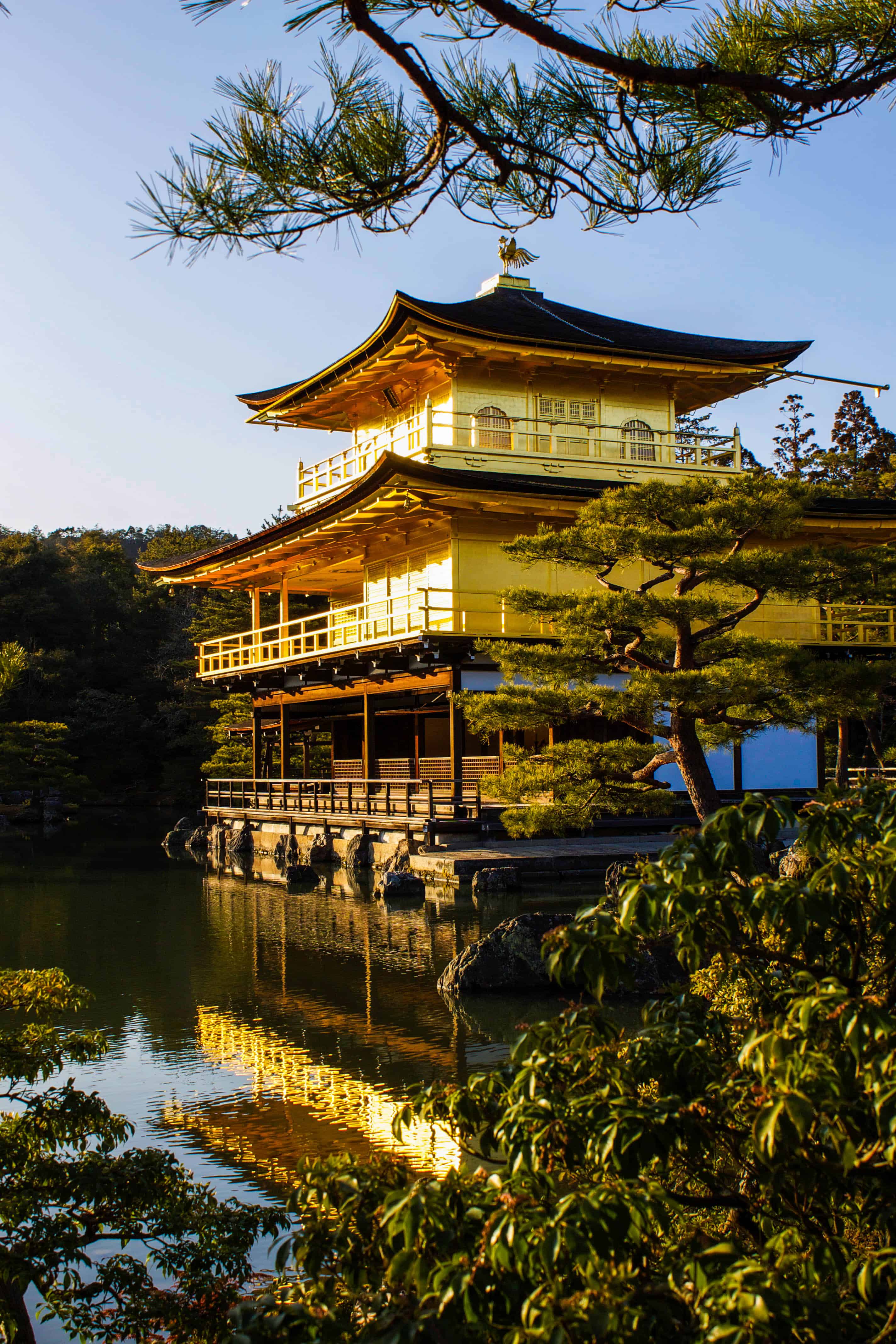
From the 8th to the 19th century, Kyoto was Japan’s capital. Though it no longer holds that distinction, it’s rich in history and home to the Kinkaku-ju Temple, or ‘Golden Temple.’ Perhaps the quintessential Zen temple got its name due to the two top floors covered in gold leaf. The temple was originally home to an aged shogun warrior who was too old for that brutal lifestyle and wanted to spend his golden years surrounded by beauty and serenity.
You’ll understand why he chose this location and style of architecture when you see it. The present building was reconstructed in the ’50s after an insane monk purportedly set fire to it. Thankfully, the damage was repaired shortly thereafter, restoring the building to its original splendor.
Visit the Tea Farms in Uji
The heart of Japanese green tea production, Uji is best visited from nearby Kyoto, which makes it a convenient day trip; you can use your rail pass if you have one. Green tea cultivation is said to have begun in Japan in the 13th century when the first seeds were brought from China and planted in Uji. Green tea has long been known to have strong antioxidants and other beneficial components in its leaves.
Many of Uji’s green tea farms remain closed to visitors, but a few have recently opened and offer tours. You’ll be amazed at how much care and modern science go into cultivating this finicky plant that is becoming increasingly popular worldwide.
Fushimi Inari-Taisha

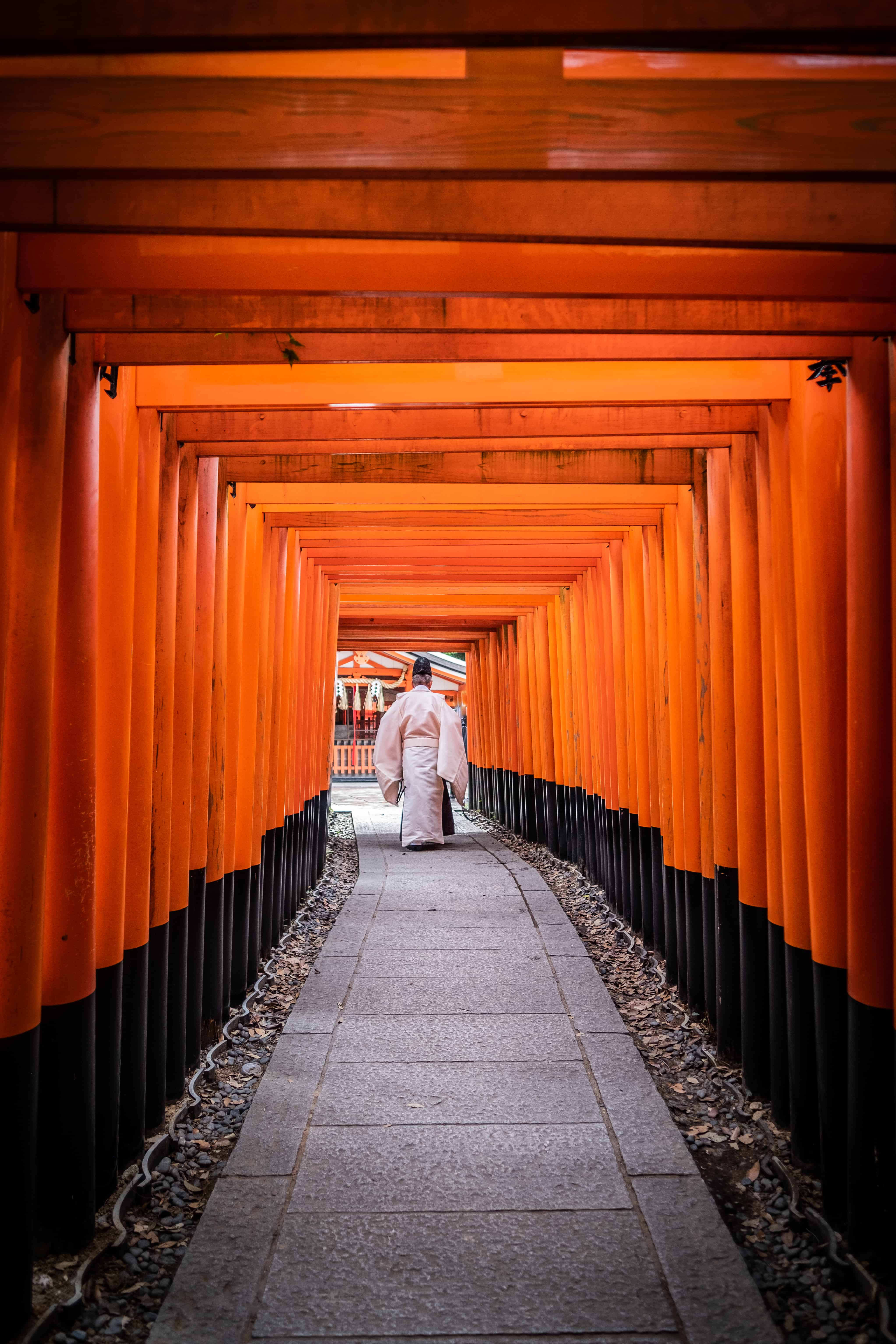
Perhaps the most famous shrine on Instagram and in Japan is Fushimi Inari-Taisha in Kyoto. This shrine is at the base of the mountain Inari and has many trails up to the mountain. It’s one of the best places to visit in Kyoto, but only at the right time.
Along the 4 kilometers of walk up, you’ll pass numerous smaller shrines to enjoy. Get here before 7 a.m. to avoid the tourist buses; seriously, if you get here after 9 a.m., you’ll be with swarms of crowds. Also, don’t take all your photos at the shrine’s entrance. Walk until you find yourself alone to grab the best picture (that’s what we did below).
Higashiyama Jisho Ji


Higashiyama Jisho Ji, or Ginkakuji (Silver Pavilion), is a stunning temple in the heart of Kyoto. It’s not silver, but it is well worth exploring. The grounds surrounding the temple are incredible and everything you think of when you think about Japan. Perfectly zen and set alongside the mountains.
It costs ¥500 to enter the grounds and takes about a half hour to explore. Get here early or late, as this site gets crowded at midday. You can reach Ginkakuji by foot along the Philosopher’s Path from Nanzenji in about 30-45 minutes or ride a bike for 10 minutes along the path.
Catch Sunset at Yasaka-no-Tou
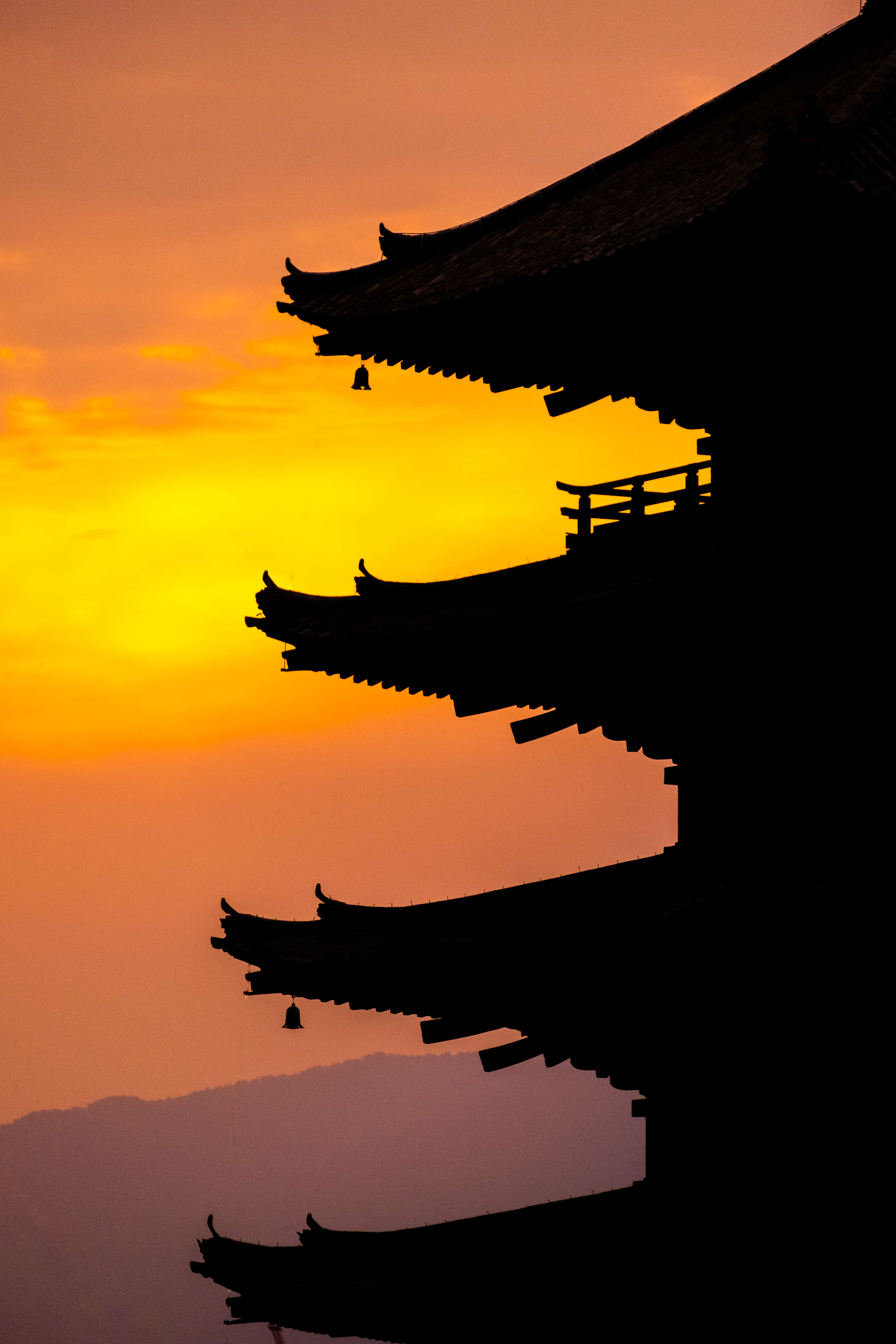
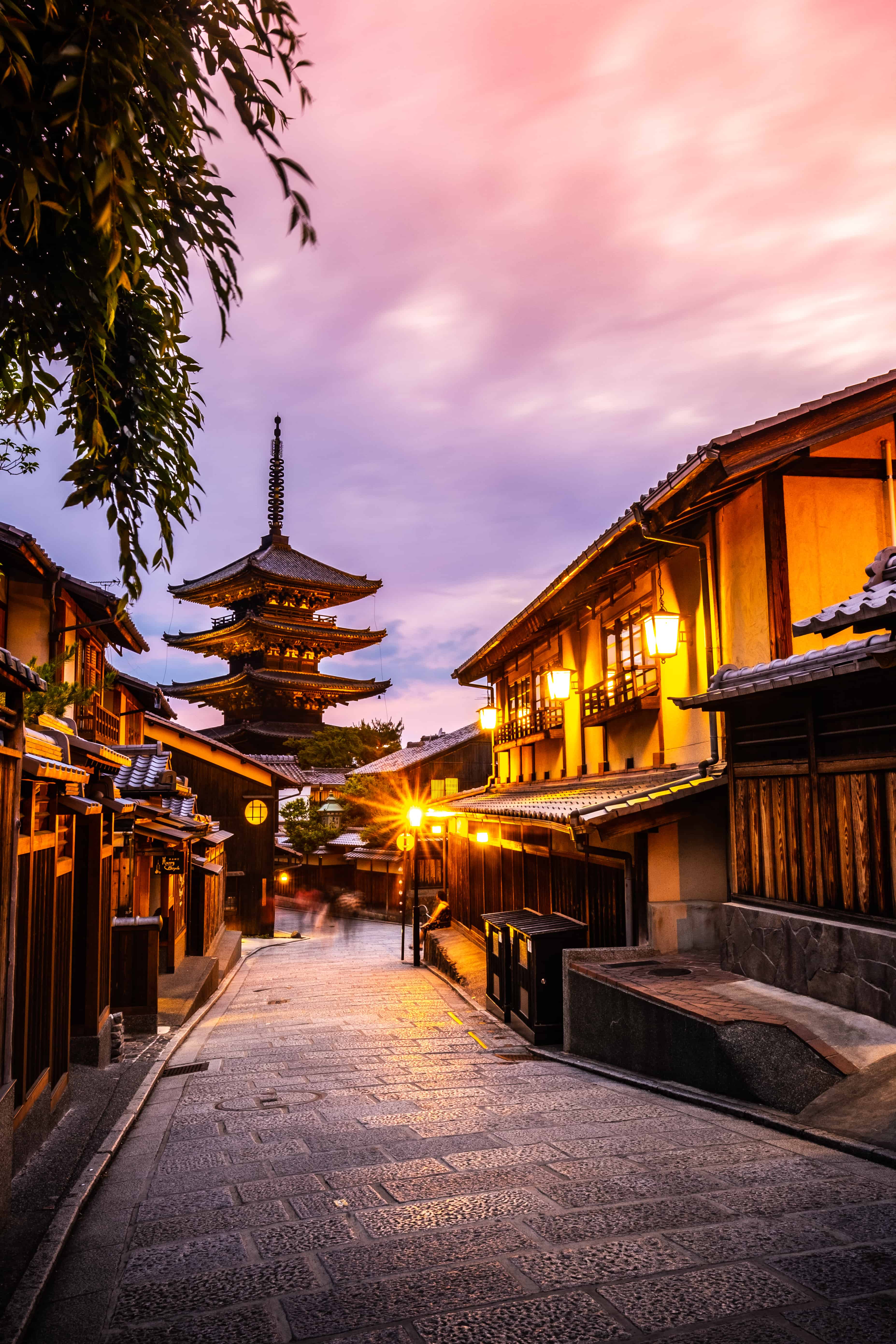
A favorite activity for photographers (and Instastars) is catching a sunset at Yasaka no Tour. Yasaka-no-Tou is one of the most iconic sights in the Higashiyama sightseeing district. This pagoda is located on the streets of Higashiyama and is truly a sight to behold.
During the day, the area is busy with tourists, but if you show up around sunset, you might get lucky with fewer people around. We had to wait until one hour after sunset for everyone to leave and get a people-free photo, but it was more than worth it. The whole area surrounding the pagoda brings you back in time.
Learn the Art of Kendo


One of the best nontouristy activities is a Kendo lesson! Kendo is a traditional Japanese martial art, which descended from swordsmanship (kenjutsu) and uses bamboo swords (shinai) and protective armor (bōgu). However, unlike Jujutsu or Judo, Kendo is not well-known outside Japan.
Despite being well known, Kendo is widely practiced in Japan. As visitors, we were able to learn the basics of Kendo in a short amount of time. We found this activity and were excited to try it in the oldest Dojo in Japan. (A Dojo is a typical Japanese hall where martial arts is usually practiced). Over two hours, we learned Kendo’s basics and fought each other and our teacher.
Kabuki Theatre
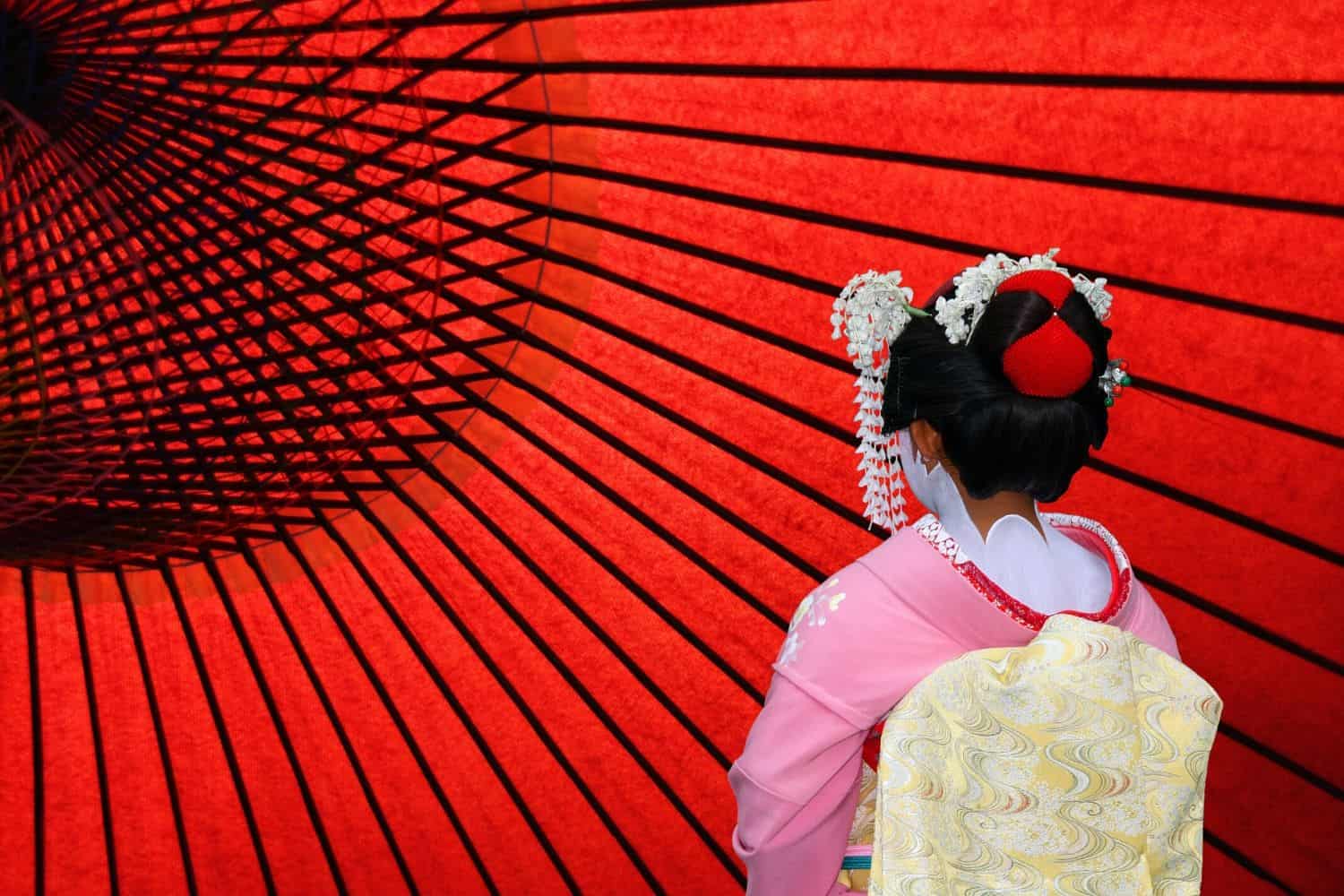
How about some Kabuki? Kabuki is a traditional Japanese dance-drama. It’s highly stylized, often comical, and known for the elaborate makeup worn by the performers. I went to my first Kabuki theatre in 2013 and laughed hard even though I couldn’t understand what anyone was saying. It’s a perfect time for visitors and Japanese. Minami-za is the main kabuki theatre in Kyoto, Japan. Founded in 1610, it is historic and beautiful, seating 1086 people.
Things to do in Nara
Todai-ji
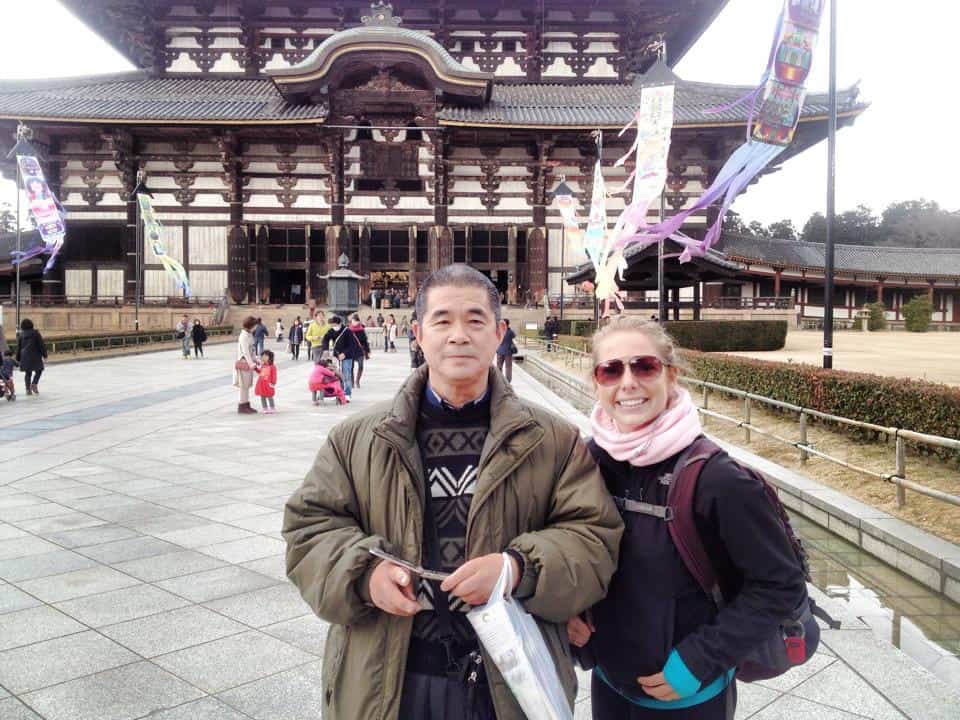
Todai-ji is one of my favorite sites in Nara. Todai-ji—or Great Eastern Temple—is famous for its architecture and tranquil setting because it houses the world’s largest bronze statue, a Buddha. Weighing nearly 400 tons, the Buddha is adorned with over 4,000 ounces of gold. This UNESCO World Heritage Site was constructed in the 8th century and includes the largest wooden structure in the world, the ‘Daibutsu’ in which the great Buddha rests.
Behind the Buddha, there’s a large wooden support structure with a hole near its base. Rumor has it that you’ll find enlightenment if you can squeeze through it. Though it’s relatively small, children and flexible adults have been known to get through, but there’s no official confirmation if they’ve achieved enlightenment. It’s free to enter the grounds, but there’s a fee to enter the building where the Buddha rests.
Kiss a Deer


Only an hour away from Kyoto is the capital city of Nara Prefecture, Nara. It is well known for its temples and shrines and is a popular stop on the Japan tourist trail. It’s well worth traveling to Nara for a day or two to visit the temples. In addition, Japanese Deer roam through town and are seen as heavenly animals protecting the country.
There are more than 1500 deer in Nara, and vendors sell deer crackers so that you can feed them, take a selfie with them, or maybe kiss them. The deer are very relaxed around humans and can even get a little excited when feeding them. The deer are what the city is most known for; they have become an emblem of Nara and appear everywhere.
Climb Through Buddha’s Nostril
Tōdai-ji may be famous for the Great Buddha and, you know, for being a hugely impressive wooden building, but there’s a cool and quirky part of this temple that you need to know about. One of the soaring wooden columns holding the temple up has a square hole through the bottom. You might see a small crowd of people gathered around it—nothing special, right?
Wrong. At just 30 x 37, the hole is said to be the same size as the Great Buddha’s nostril. Called hashirakuguri – literally “pillar passage” – the idea is to see if you can fit through the hole to the other side. If you can make it, you get at least some enlightenment points. That’s because you’ve humbled yourself enough to try and squeeze through a tiny hole while a crowd of onlookers giggle.
Walk Amidst the Mossy Lanterns at Kasuga-Taisha

Another famous Nara attraction is Kasuga-taisha. Kasuga-Taisha, or Kasuga Grand Shrine, is the principal Shinto shrine in Nara and a UNESCO World Heritage Site. Founded in the 8th century, it’s a special place to wander around, especially in the early morning or evening.
The hundreds of moss-covered stone lanterns here—more than 3,000 of them—and the serene, ancient forest setting make for a tranquil stroll, especially at the above times (when there are fewer tourists). In the mornings, you can also experience the chanting ceremony, during which the Shinto priests pray for the safety of Japanese nature and people. Interestingly, this practice started after the 2011 Tohoku Earthquake.
Discover Traditional Nara-machi

You may be thinking Kyoto when you think “traditional wooden Japanese houses” – which isn’t necessarily un-true – but Nara has its own machi, or ‘town’ area, that makes for a charming wander around. Machi conjures up more of a traditional part of town than anything else, and Nara-machi is he city’s old, charming, wooden heart.
You’ll find old townhouses, old storehouses (kura), and many that have been converted into shops, cafes, and guesthouses. The Nara-machi Koshi no Ie is an old merchant’s house that you can enter and explore. It’s like going back in time, complete with the original kitchen. There’s a gallery that you can check out, too: Nara-machi Monogatari-kan.
Things to do in Kobe
Meet Tetsujin 28 Robot
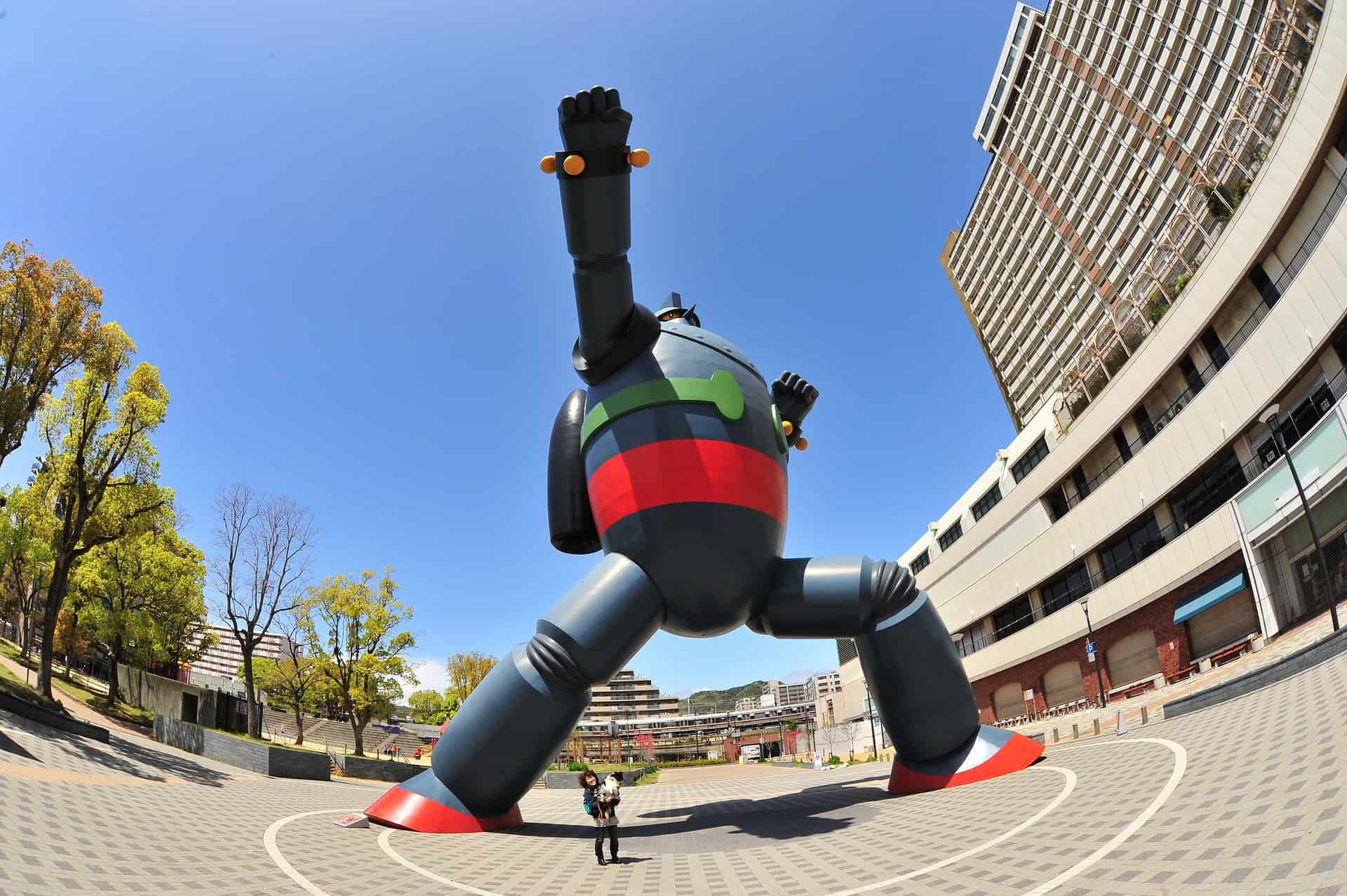
The towering 59-foot-tall figure of Tetsujin 28 Robot symbolizes the strength and resilience of the city of Kōbe. The effects of the 1996 Hanshin Earthquake hit Kōbe badly, but the disaster would never stop the people of Kōbe. After much rebuilding and community coming together, Tetsujin 28 was erected in one of the city’s parks to protect the city from further destruction.
The original manga, created in 1960 by Mitsuteru Yokohama, a Kōbe local, tells the tale of a robot who helps stop baddies. The robots’ location in Wakamatsu Park was also intended to bring more tourists to an area torn apart by the earthquake.
Eat some world-famous Kōbe beef

Kōbe beef is a delicacy around the world. Fatty, well-marbled Kōbe beef comes in various forms: teppanyaki, shabu-shabu, and even sashimi (yep, that’s raw). Kōbe beef, a registered trademark, is just one of many Japanese types of wagyu (Japanese beef). If it’s to be called Kōbe beef, the marbling ratio has to be just so, the cattle themselves have to have been raised in Hyōgo Prefecture, and several other strict guidelines apply to this foodie favorite.
Of course, the best place to try Kōbe beef is… in Kōbe! There are numerous places to try. Hit up Wakkoqu for various cuts cooked directly in front of you, or Wanto Burger has a diner vibe featuring Kōbe beef hamburgers. Make sure to do your research before you sit down at a restaurant. There are no deals on the real deal, so if you’re getting a “good” price, you’re not getting high-quality Kōbe beef.
Sip sake at Nada-Gogō

Nada-Gogō (meaning “Five Villages of Nada”) is an area famous in Japan for its sake – Japanese alcohol made from fermented rice. Not only is this area fun to walk around, complete with wooden brewery buildings, museums, and traditional houses but the sake tasting? Yeah, you’ve got to come here. If alcohol is your thing, then this is going to be one of the best things to do in Kōbe for you.
Three of the five villages are located within the boundaries of Kōbe City itself. These are Uozaki-gō, Mikage-gō, and Nishi-gō. This is where you’ll find the most sake breweries, where tours and tastings can be arranged. (The other villages are called Nishinomiya-gō and Imazu-gō).
Nada-Gogō is famous because it’s vast, accounting for a quarter of all sake made in Japan. Dating back around 700 years to 1330, the breweries here use famous sake-making rice called Yamada Nishiki. The water that flows from Mount Rokkō and mountain winds act to cool and slow the fermentation process.
Things to do in Tokyo
Koishikawa Korakuen Natural Garden

Located in the Bunkyo area of Tokyo, Koishikawa Korakuen is a traditional Japanese garden built in the early 17th century. Like most natural spaces in Japan, it has elements of both Japanese and Chinese design. The designers did an amazing job combining components of the manmade and natural worlds into a tranquil setting that will immediately lower your blood pressure upon entering the grounds. The garden’s trees are particularly popular for fall maple leaves, especially in November and December, and the cherry blossoms bloom in March and April.
Tokyo Disneyland
Tokyo Disneyland is the second-largest theme park in the world, it is the first Disney park built outside of the United States and was completed in 1983. Since then, it has hosted nearly 700 million guests worldwide, who couldn’t resist this fun and popular icon of American culture.
With more rides, activities, and recognizable characters than you can cover in a day, your time here will fly by. During peak times, the park can be unpleasantly crowded, which means long waits for rides and activities that may make everyone edgy. If possible, plan to visit during the week or in the off-season.
Mount Fuji

At over 10,000 feet, Mount Fuji is the largest mountain in Japan and one of the most recognizable in the world. It’s no wonder that it has been revered as sacred for centuries. Though it’s still an active volcano, Mount Fuji luckily hasn’t erupted since the early 18th century. Despite the distance, it can be seen from Tokyo on crisp, clear days.
Despite its height, it’s a relatively easy hike to the topmost vista point; the climbing season is from July to August. But it’s not an easy hike and best left to the fit. The mountain is also visible from the train from Tokyo heading toward Osaka and Kyoto, but only if there isn’t cloud cover. There are scenic lake resorts and a natural hot spring nearby, which are great starting points for your Mount Fuji adventure and will be welcome places to return to after a day on the mountain.
Visit the World’s Tallest Tower

Officially standing just a tick over 2,000 feet, Tokyo Skytree is the tallest tower in the world and happens to be standing in the most populated city in the world. With different viewing areas at intervals on the tower, Mount Fuji – more than 80 kilometers away – can be viewed from the highpoint if the clouds and weather cooperate.
Though its primary job is a communications tower, it hosts swanky shops, restaurants, and cafés. The observation areas are at 350 and 450 meters, giving panoramic views of the city and surrounding countryside, which are unparalleled, especially as the sun goes down. Though it was supposedly built to represent a pagoda, you may not see the similarity – but you’ll be impressed nonetheless.
Senso-Ji Temple


One of the top things to do in Asakusa, Tokyo, is to see Senso-Ji Temple. Senso-Ji is an ancient Buddhist temple, Tokyo’s oldest temple. Dating back to 645 AD, this temple is absolutely beautiful. You can’t miss Kaminarimon or “Thunder Gate,” which marks your entrance into the temple. A stop here is worthwhile but beware of the crowds. Next to the temple is a five-story pagoda, which you can’t go into but can easily take many beautiful photos!
Nakamise-Dori is a street leading up to Senso-Ji, a street leading from the Thunder Gate to the main temple. This is 250 meters of pure Japanese shopping bliss. As you approach the temple, you’ll find anything from children’s trinkets to delicious Japanese sweets. My biggest tip for visiting Senso-Ji is to arrive right around sunrise or after sunset. It’s one of the busiest tourist stops in all of Tokyo and has year-round crowds.
Be Amazed in Akihabara

The Akihabara district in Japan is one of great cultural interest. It’s been nicknamed Akihabara Electric Town for being a huge shopping area for electronic goods and post-WWII black market goods. Visit now, and you will be blown away by the sights, noises, and shopping experience.
Be prepared for plenty of video games, anime, manga, and maid cafes. I loved wandering around this district and entering the stores that seem to go on for 7 to 8 stories. For a real treat head here after dark, it’s one of the best places in Japan at night.
Things to do in Hiroshima
Visit the Hiroshima Peace Memorial Museum
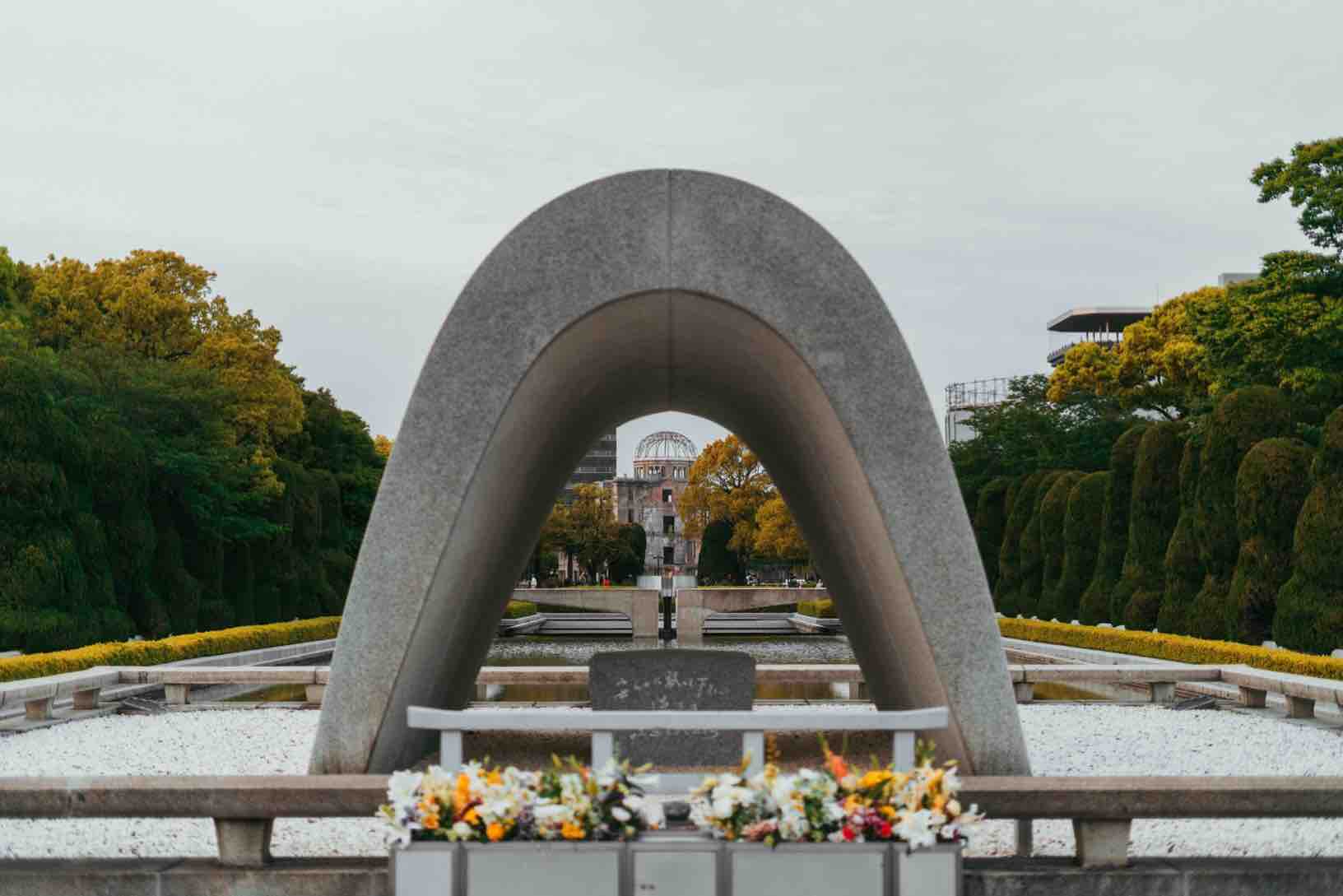
If you only have one day in Hiroshima, you should visit the Peace Memorial. For better or worse, Hiroshima is famous as being the first-ever place where an atomic weapon was used against people. It happened on the morning of August 6, 1945. In an instant, much of the city was obliterated, and 70,000 people were killed. A further 70,000 suffered fatal injuries as a result of the blast. Radiation sickness affected countless more.
Rather than play the blame game, the museum presents facts in harrowing detail, making sure you leave thinking, “Wow, this really should never, ever happen again.” (Though it did – in Nagasaki, three days later). The museum’s location, Peace Memorial Park, is a pretty chilled place to contemplate things after a trip around the hard-hitting exhibits.
Go to the Atomic Bomb Dome

Inextricably linked to the atomic bomb blast itself is the seriously must-see Atomic Bomb Dome, or Genbaku Dome. What is it? It’s the ruins of Hiroshima Prefectural Industrial Promotion Hall, a Western-style building designed by Czech architect Jan Letzel. It was used for art and educational exhibitions. Today, ravaged by the 1945 blast, it has been left as it was to serve as a reminder of the destruction – a slice of crumbling, post-apocalyptic potential in the middle of a city working hard to forge a peaceful future.
See the Floating Torii of Itsukushima Shrine

Another of the most famous landmarks of Hiroshima has got to be this icon – the floating torii at Itsukushima. An aspect of Japanese Shinto shrines is their tori – or gates – often painted vivid vermillion, signifying a sacred place. What’s special about the one on the island of Itsukushima (or Miyajima, as it’s more commonly known), is that it is embedded just offshore, so it appears to be floating.
The shrine itself is on a site first said to have been graced by a shrine in 593 AD, but the current design is 16th-century. Also on stilts, at high tide, it looks like a sea palace, which is pretty awesome. At low tide (the least Instagrammed side of the torii), you can see all the five-yen coins that people have wedged into every crack they can find. Locals pick through shellfish in the wet sand, too. It’s a pretty cool time of day to be there.
Visit Hiroshima Castle

Hiroshima Castle is one of the great things to see in Hiroshima. Originally built in the late 16th century, Hiroshima Castle (or Carp Castle, as it’s sometimes affectionately known) may be a 1950s reconstruction, but visiting it is nevertheless one of the top things to do in Hiroshima. You can guess what destroyed the primarily wooden castle in 1945, right?
While the castle itself can be explored in a museum-like fashion (which further tells the story of not only the castle’s history but also the A-bomb), the grounds within the castle walls also make for an interesting stroll. Cherry blossom is pretty stunning here against the castle backdrop. Another of the city’s nature spots, it’s even home to three trees that somehow survived the blast of the atomic bomb – a eucalyptus, a willow, and a holly.
Things to do in Hokkaido
Enjoy The Epic Japow Conditions
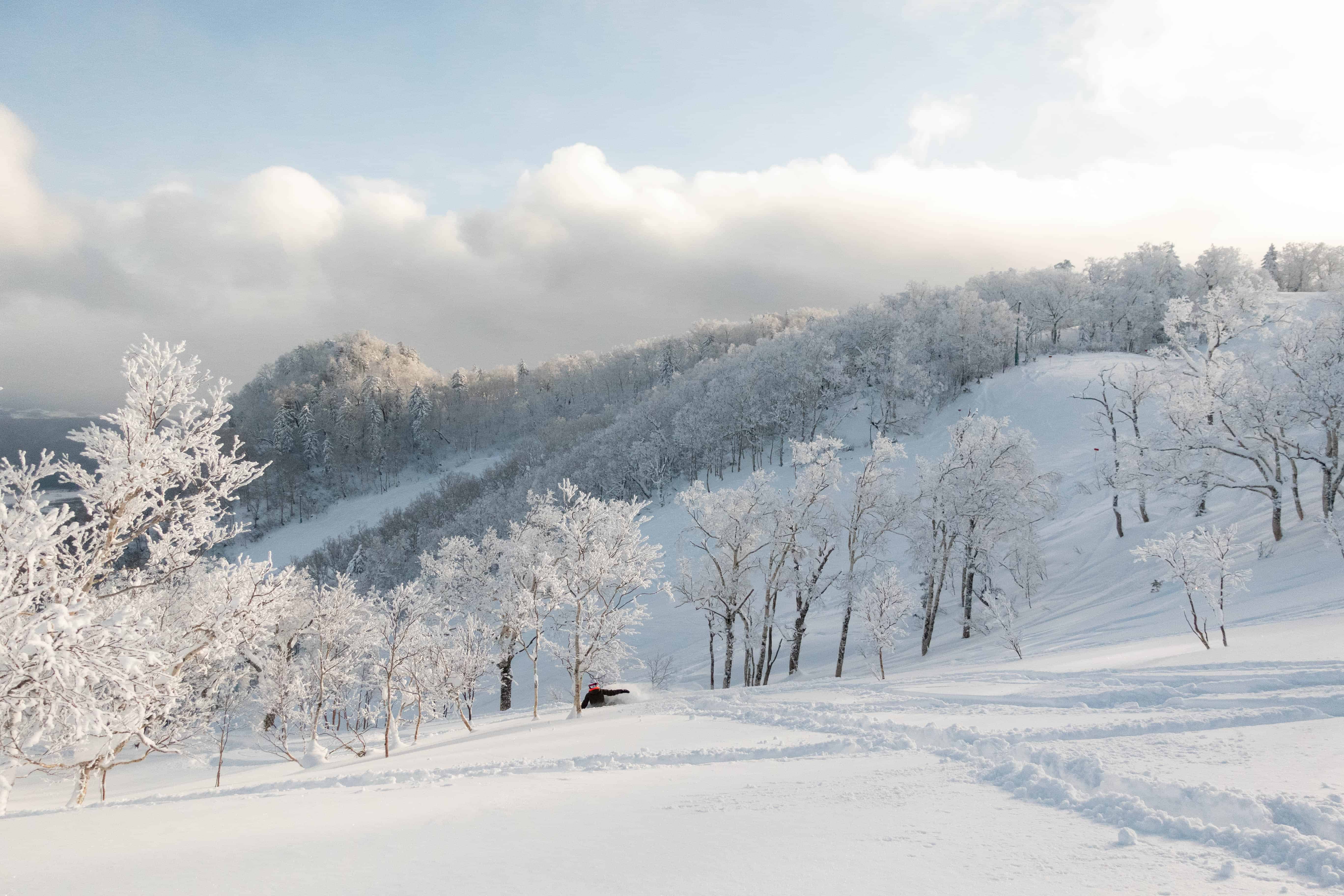
Hokkaido is known for its epic dry powder that falls across its mountains and ski resorts. For skiers and snowboarders, the island has become a place of pilgrimage in search of the legendary “Japow.” Although the slopes are mellower than those in the Swiss Alps or North America, the snow is dry white magical fluff that doesn’t seem to stop falling between December and March. We recommend visiting resorts like Furano, Rusutsu, Kiroro, and the popular Niseko.
See the Lavender Fields of Furano

Furano is a fantastic little town in Hokkaido that is well known for its lavender fields, which appear in the spring and summertime. The best time to see the lavender fields is in July, when they are in full bloom. Also in the area are the town of Biei, a beautiful blue pond nearby, and the Furano Winery and Cheese Factory. The whole area is surrounded by mountains, and if you have your own car, you can easily get out into nature and discover something new.
Have a beer at the Sapporo Beer Museum

You’ve likely heard of or even drank Japan’s delicious Sapporo Beer. The beer Sapporo Breweries Ltd.’s first brew came right out of Hokkaido’s capital city, and if you’re visiting Hokkaido, it is obligatory to have a Sapporo beer there. We couldn’t miss having one at the Sapporo Beer Museum, one of our favorite things to do in Sapporo.
The museum is located just a few subway stops from Sapporo city center and is well worth a few hours’ visit. Museum tours are free to the public, but if you speak Japanese, you can go on a guided tour for 500 ¥, which includes a beer tasting at the end. As foreigners, this wasn’t an option for us, but we could read all the signage with English translations and enjoy a tasting flight for 600 ¥ at the end!
Visit the Sapporo Snow Festival

Possibly the most famous thing about Sapporo (okay, maybe after its beer) is the Sapporo Snow Festival. Once more of a domestic affair, this huge winter festival is now truly international, attracting well over two million visitors yearly.
One of the festival’s most iconic aspects is the snow sculptures in Ōdōri Park. Using around 30,000 tons of snow, the sculptures—also carved from ice—are made over the course of a month and range from fantasy castles to popular characters like Doraemon.
How did it start? In middle school, students 1950 began making sculptures out of all the snow that everyone dumped at Ōdōri Park from snow clearance. The rest is history, and today, each festival boasts over 200 sculptures worldwide. The Sapporo Snow Fest usually runs the first two weeks of February and is one of the top things to do in Sapporo in the winter.
Take a day trip to Otaru

Just outside Sapporo itself but close enough to make a super convenient day trip, Otaru is a cool place to visit. With its romantic, Western-style buildings, old warehouses, and canal, it’s steeped in history. Otaru was actually the original terminus for Hokkaido’s first railway system, so it was big news —back in the day, at least.
That was also thanks to the herring industry here, which is no more. Today, the Victorian-style gas lamps and the grand Western buildings of Nichigin-dori provide remnants of its glory days. For Instagram friends, there’s the Otaru Snow Light Path Festival; every year in mid-February, tiny snow lanterns hide candles along the canal and other areas to beautiful effect.
Things to do in Osaka
Osaka Castle
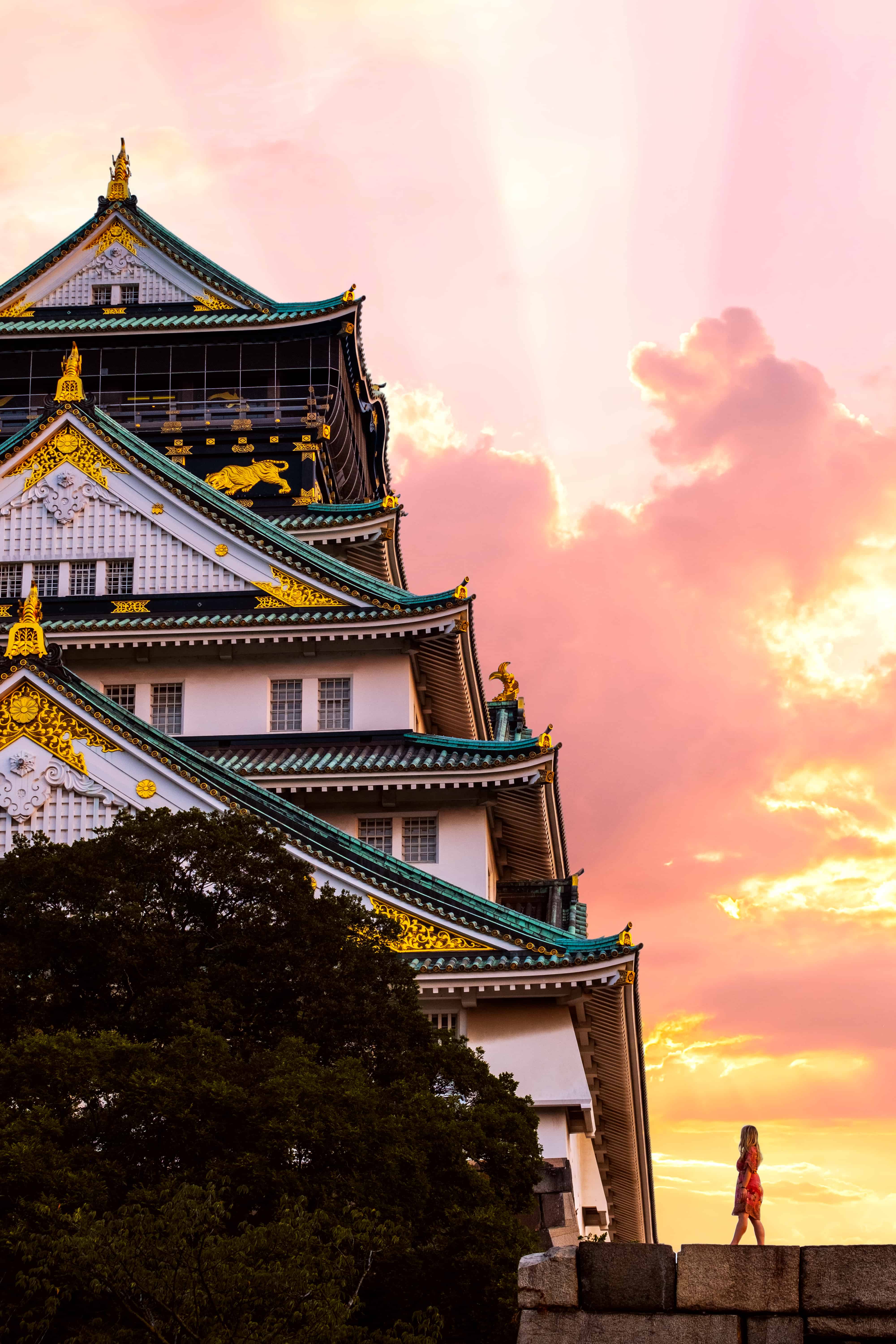

One of the greatest places of interest in Osaka is the Osaka Castle. Though Japan isn’t a country most people associate with castles, you’ll be surprised at how many there are. Osaka Castle is one of the country’s largest and has seen its fair share of important historical events since it was built in the 16th Century. Built by the warlord Toyotomi Hideyoshi, who was an integral figure in the country’s unification, the current castle is a reproduction that was completed in the 90’s because the original was destroyed by Allied bombers in 1945.
During World War II, the castle played a central role in Japan’s munitions industry, so it became a high-priority target for aerial bombardment. But don’t worry—you’ll never know it’s not the original. You’ll still be impressed by the stalwart stone walls, moats, turrets, and architecture. There’s a fascinating and educational museum inside that will fill in all those important details, too.
Amerika-Mura

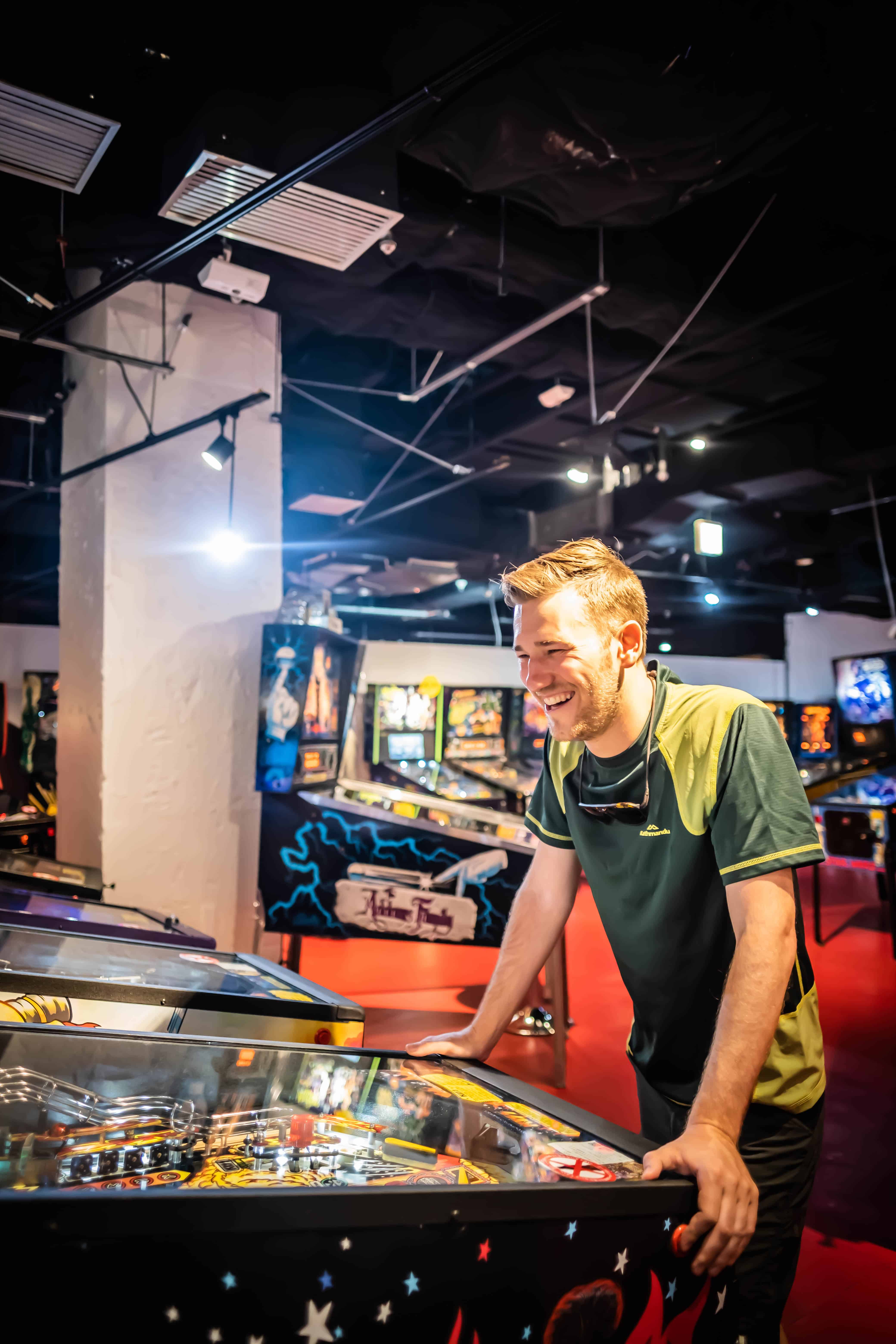
Japanese for “American Village,” America-Mura is a chic pocket of hipster-ridden coffee bars, shops, tattoo parlors, clubs, and hotels catering to young lovers’ trysts. Though you may not think it has much in common with any town in America you’ve ever visited, it got its name after World War II, when the devastated country began the slow process of rebuilding; this area was the place to go to get American goods like t-shirts, razors, and cigarettes.
Sitting starkly in the middle of the village is a park constructed of concrete called Triangle Park, which is known as a rallying point preceding a night on the town (it’s also the dirtiest spot we’ve found in Japan – tons of litter).
There are also many bold murals – some of which have been painted by famous, contemporary Japanese artists – and there’s even a pint-size Statue of Liberty if you’re feeling homesick or want a quirky photo to show your jealous friends back home. Though the area is fun and lively, it’s not a great place for families after the sun goes down.
Den-Den Town
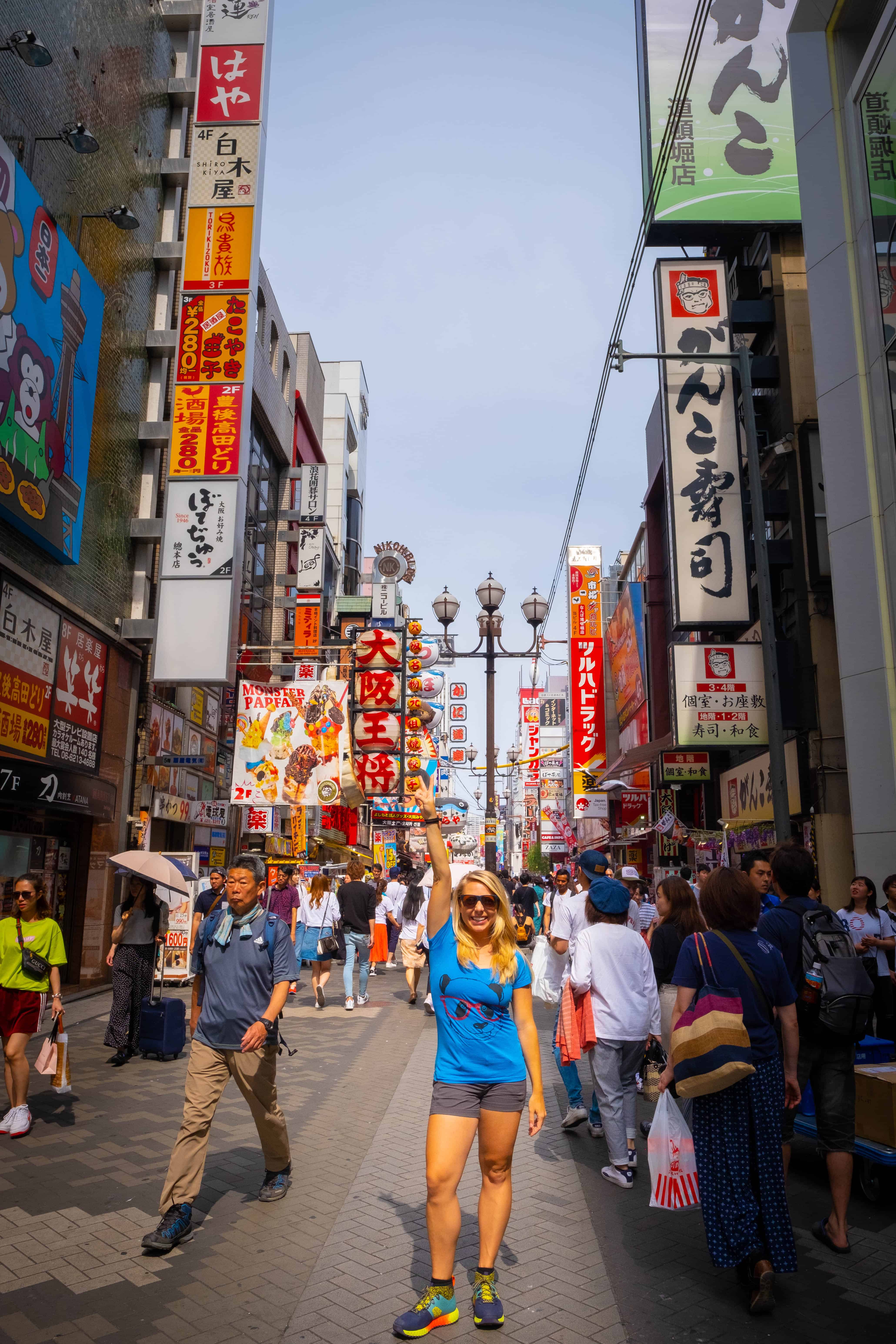

Also called Nipponbashi, Den-Den Town is a shopping district in Osaka famous for electronics and otaku – an often-derogatory term used to describe people whose interests in anime and other fetishes are borderline neurotic. The name became mainstream after one of Japan’s most infamous psychopaths and serial killers was dubbed the otaku murderer.
The term is becoming less negative, though, and the district has a reputation for eclectic nerdiness, which most find endearing. Due to the competition between electronics vendors, it’s okay and even expected that you’ll haggle over the price if you decide to buy something to take back with you.
Walk Around Dotonbori


One of the best things to do in Japan is see Dotonbori at night. Dotonbori is one of the most popular places to visit in Osaka. It’s a lively area that is as crazy as it looks. If you want bright lights, crowds, restaurants, food stalls, and plenty of shopping, then travel to Dotombori.
Dozens of restaurants line the Dotomborigawa River, and while you’re enjoying dinner, you can admire the numerous billboards. Afterward, a popular thing in Osaka is an evening cruise on the river. It’s always busy, but at night, it comes alive.
Other Things to Do in Japan
Nikko National Park
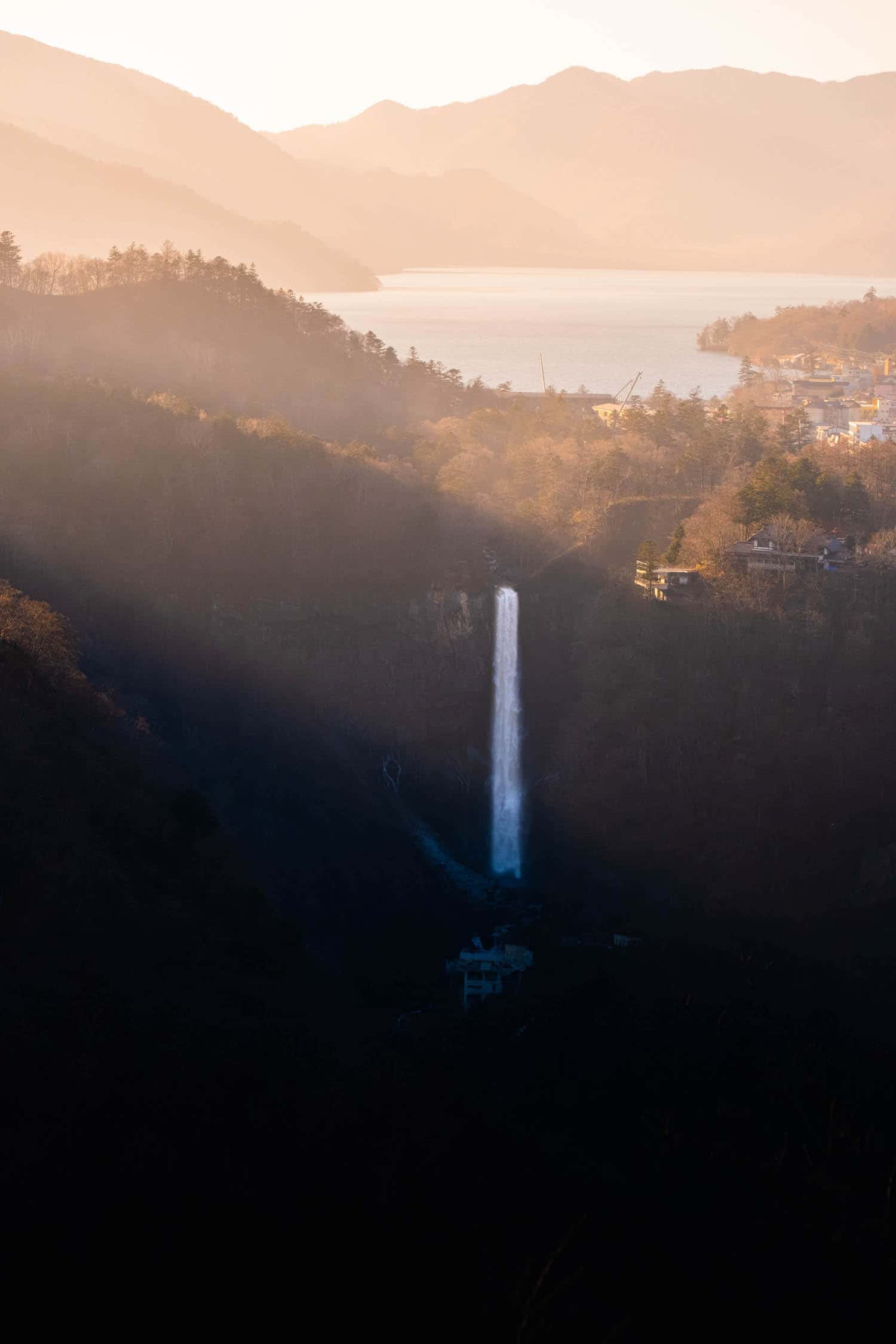

Located more than 100 kilometers north of Tokyo, Nikko National Park is the perfect destination for a one or two-day trip from Japan’s capital. Chockful of natural wonders like lakes, rivers, mountains, and waterfalls, the park is also famous for the Toshogu Shrine, considered one of the country’s most ornately adorned shrines.
Though stunning at all times of the year, the park is exquisite in autumn, when the tree’s leaves turn spectacular shades of orange, red, and yellow. There is an ancient Shogun’s mausoleum, the famous statue of Three Wise Monkeys, and more picturesque bridges and shrines than you’ll know what to do with. If you’d like to get in a little exercise, there are plenty of hiking trails too.
Nippon Maru
Located in the Port of Yokohama, the Nippon Maru is a 1930s wooden sailing ship that purportedly has enough miles to circumnavigate the globe dozens of times. Though she’s getting old, the boat has been lovingly restored to near-original condition. Over its lifespan, the ship has been a transport and training vessel and was still in use in the ’80s, when it was converted to a full-time museum.
At over 300 feet long, with 30 sails and an impressive array of masts, the ship exhibits its history and that of the Japanese Navy, whose officers were trained on the ship for generations. The ship and Yokohama Port Museum are on the waterfront just across from the Landmark Tower and are an easy stroll from the Metro station.
Matsumoto Castle

Known as ‘The Crow’s Castle’ because of its ominous black façade, Matsumoto Castle is Japan’s oldest castle. It’s rich in history and, due to its dramatic architecture, is considered to be among Japan’s elite castles. Construction on the castle was completed in the mid-1500s. Among its formidable defenses are a moat, sheer stone walls, and various gatehouses from which defenders had easy shots at those brave enough—or foolish enough—to lay siege to the castle.
Most of its life was spent as a home and fortress to the warlords who reigned in Japan’s feudal period. The castle nearly collapsed in the 19th century but was refurbished three times in the last 100 years. It’s an easy walk from the Matsumoto metro station, and plenty of lodging if you decide to spend a night or two. The cost of the tickets to the castle includes entry to the Matsumoto City Museum as well. Heading to Matsumoto Castle in April is one of the best things to do in Japan, as you might get the chance to see it among the cherry blossoms.
Himeji Castle

In contrast to the dar Matsumoto Castle, Himeji Castle – located in the Hyogo Prefecture – is bright white, giving it the name ‘White Egret’ or ‘White Heron Castle.’ Considered the finest example of purely Japanese architecture, the castle complex includes 83 buildings, perpendicular stone walls, a moat, and defensive guard posts.
These structures served it well through the tumultuous centuries of Japan’s feudal period, characterized by constant warring between the various warlords who controlled areas of Japan’s countryside. The castle’s prominence over the surrounding ground, gleaming white façade, and elegantly terraced roofs will leave you speechless.
Beach Time at Okinawa

The southernmost islands in the Japanese archipelago, the Yaeyama Islands – of which Okinawa is part – are home to white sand beaches, impossibly blue skies, and palm trees swaying in the stiff Pacific breeze like few other places on Earth.
If you’d been blindfolded, teleported, and plopped down here and weren’t sure where you were, you might think Hawaii, especially due to the American influence that comes with the large US Navy and Air Force bases nearby. Peppered with hotels in every price range and lots of scenic views and places to relax, eat, and drink, this may be the most satisfying time you’ll spend in Japan.
Enjoy Happo One

One of the best things to do in Japan in the winter is ski or snowboard. If you can’t make the trip to Hokkaido to go skiing, the island of Honshu has some great ski resorts. Happo One is located on Mount Karamatsu in Hakuba, Japan, and is very easily accessible if you have the JR Pass. It is a good family-friendly resort with lots of skiable intermediate terrain.
Surround yourself with Bunnies

One of the most interesting places in Japan is Rabbit Island. Yes, you read that right. On the small Japanese island of Okunoshima lies a land filled with enough Peter Cottontails to fulfill all your childhood dreams. During WWII, the isolated island served as a top-secret location for a poison gas factory. Rabbits were used as test subjects for chemical weapons such as tear and mustard gas. Now, there are more than 1000 bunnies on this island living wild and free, and you can go there and cover yourself with them all (as long as you have some food).
The only way to Rabbit Island is via the Okunoshima ferry. From the mainland to Okunoshima, it takes less than 20 minutes and about 12 minutes, costing 620 ¥. Make sure to bring some change with you so you can purchase rabbit food. Please don’t bring your food and feed it to the rabbits; human food is bad for their digestion.
Get Inspired on Naoshima

Naoshima is an island town in Japan’s Seto Inland Sea. I like to call it “art installation island” because it’s well known for its numerous art museums and projects. The Benesse Corporation has installed many museums, installations, and sculptures on the island.
The Benesse House is an interesting art museum/art hotel to visit. Besides that I recommend walking around and seeing the interesting sculptures, there’s also a bus to take you around the island. Apart from the art, the island has all the features you could want on a sunny day: Sandy beaches and beautiful water.
Things to Eat in Japan
Take a Sushi Making Class
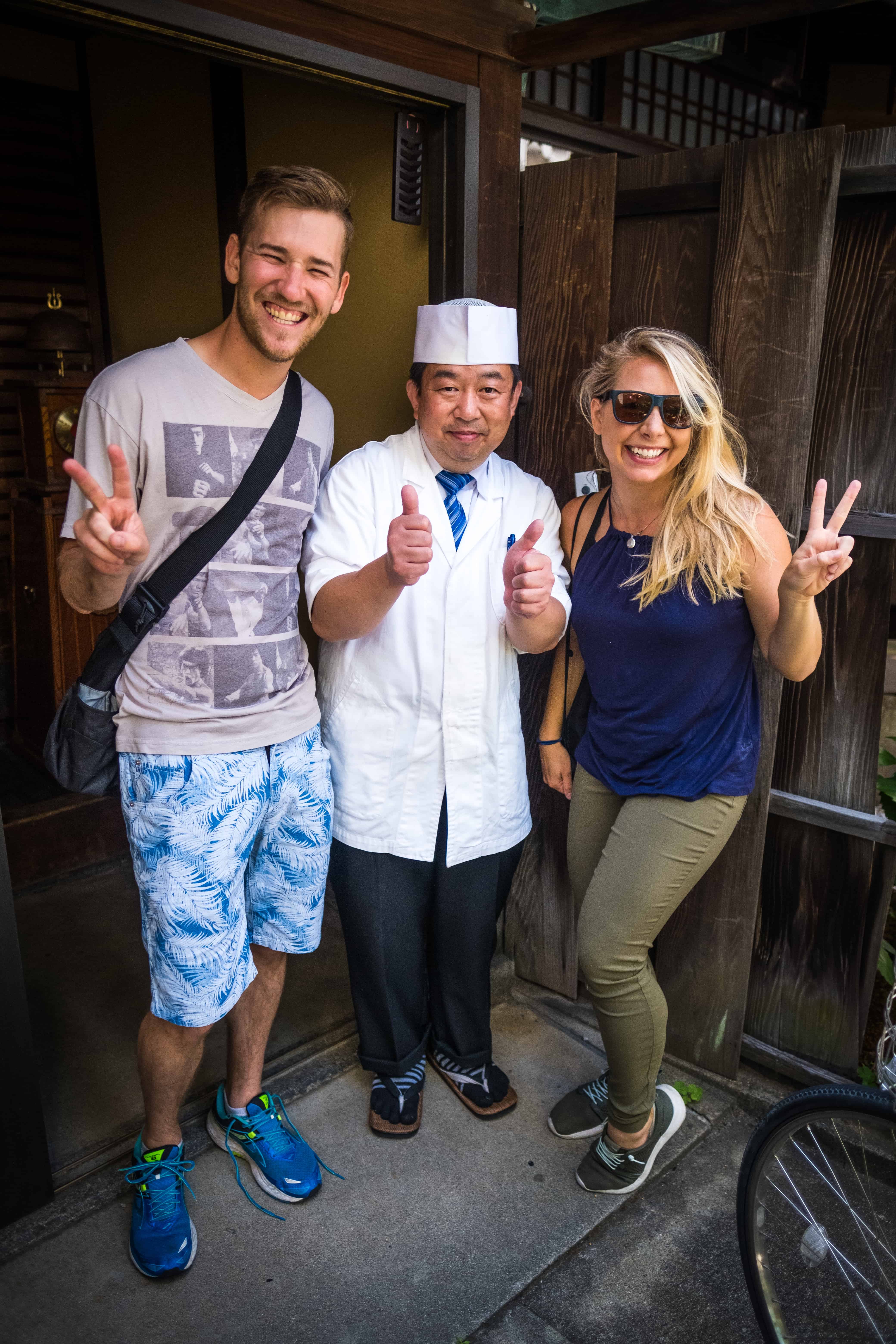

If you are a sushi connoisseur like us, it’s only fitting to take a sushi-making class (and then eat your creation) while in Japan. For one hour, we were given an in-depth sushi-making class by a top Kyoto sushi chef. Afterward, we got to put our sushi to the test and taste it all ourselves. You may have taken sushi classes elsewhere before, but I believe there is no better place than Japan. You can often find sushi-making classes in any Japanese city.
Have Conveyor Belt Sushi

While sushi is probably a special and expensive meal out where you live, you can find it for an affordable price in Japan. Of course, there are costly world-class options, but Japan has affordable conveyor belt sushi options. Conveyor belt sushi is a quick and cheap meal in Japan. Sushi is made and sent out onto a train like a conveyor belt which will rotate around the restaurant.
Guests can grab what they please and then at the end of the meal the waitress will come to tally up the plates to give a total for the meal. The plates are different colored, and the higher grade sushi goes on more expensive plates, which are all color-coded. Typically, you can get two pieces of nigiri for ¥100 to ¥200, and then the prices go up depending on the fish cut. You can easily walk out of a sushi conveyor belt meal feeling stuffed with high-quality fish for under ¥1500. That’s the price of mediocre sushi in the United States!
Try Real Matcha
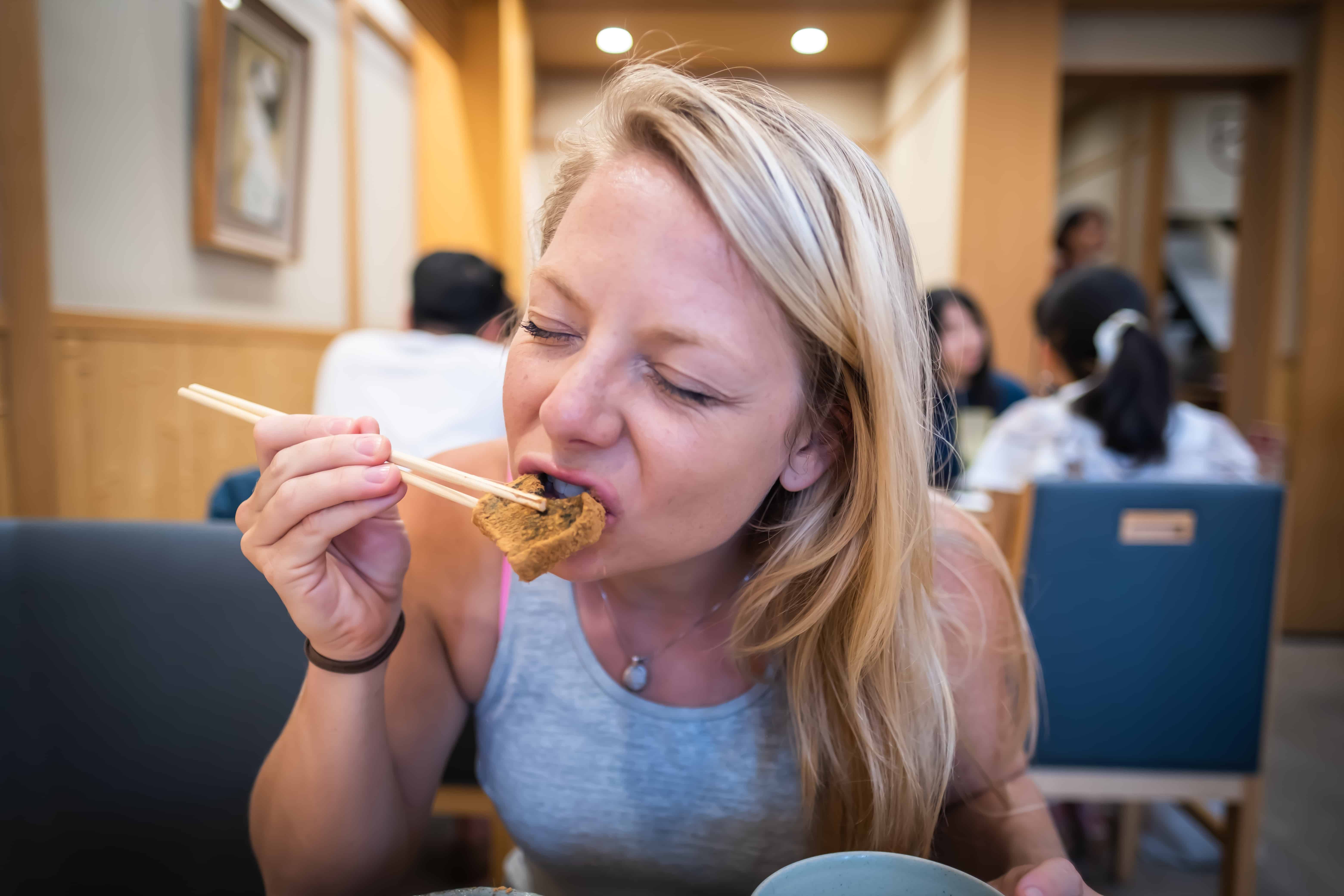
Kyoto is known for having the best matcha in all of Japan. The city’s specialty is “Uji matcha,” regarded as the highest quality green tea. There are plenty of high-end Matcha cafes around Kyoto where you can enjoy real matcha. A few notable ones are Charyo Tsujiri, Nakamura Tokichi, and Umezono. You can expect to try things like Matcha pancakes, Matcha sundaes, or traditional matcha tea. Many matcha cafes exist in different Japanese cities, but Kyoto is well-known for them!
Try Genghis Khan


Sapporo has so many great places to eat. One night while there, we were wondering what to eat and figured we would give the famous Genghis Khan a try. Genghis Khan (Mongolian barbecue) is a Hokkaido local dish that consists of grilling mutton and vegetables on a unique grill with a raised mound in the center. The most popular place to try Genghis Khan is in Sapporo, and locals regard it as soul food.
Genghis Khan is more of a dinnertime meal and usually involves several rounds of beer to wash down all the flavors. Genghis Khan is served tapas style, and you can continuously order as much as you like. You will also receive a side of delicious sauce to dip your meat and vegetables in. At the end of the meal, it is very common to drink that side of sauce, signifying you are done and satisfied.
Enjoy a Yakitate Cheese Tart

If there is one dessert in the world, I will fly halfway around for the Yakitate cheese tart, which is only found in Hokkaido. The island is famous in Japan for its high-quality milk, which means its cheesecakes are renowned. They are all delicious, but the Yakitate Cheese tart is the best.
This cheesecake is baked in the oven after cheese mousse is poured into cookie dough. The outside shell is a crispy cookie, with the cheesecake in the center. There’s a Kinotoya Bake shop at Sapporo Station, where you can get one (or six), and one at New Chitose Airport as well.
Try Okonomiyaki

Okonomiyaki is a Japanese savory pancake filled with cabbage and many other toppings. It is a staple food to try in Japan and can be found around the country. Okonomi means “as you like it,” and yaki means “grilled,” so it’s a meal catering to your preferences. It’s a quintessential Japanese dish that everyone should try!
Okonomiyaki is said to originate from Osaka, so having it in the city is a must. We scoured Dotonbori for the best Okonomiyaki in Osaka and landed on Creo-Ru Takoyaki & Okonomiyaki. Depending on the type of Okonomiyaki you order, you can expect to pay between ¥700 and ¥1300 for one pancake. However, we found one was more than enough for two!
Try Takoyaki

Takoyaki is a ball-shaped Japanese snack made out of wheat flour-based batter. It is typically topped with tempura scraps, pickled ginger, and green onion and then brushed with takoyaki sauce and mayonnaise. It’s a sweet and savory snack that will fill you up at least a little bit. It became popular in Osaka in the mid-1930s, and nowadays, you will see street vendors selling Takoyaki down Dotonbori Street. The most famous place to try Takoyaki is Aizuya, which is recommended in the Michelin guidebooks.
Try Jiggly Cheesecake
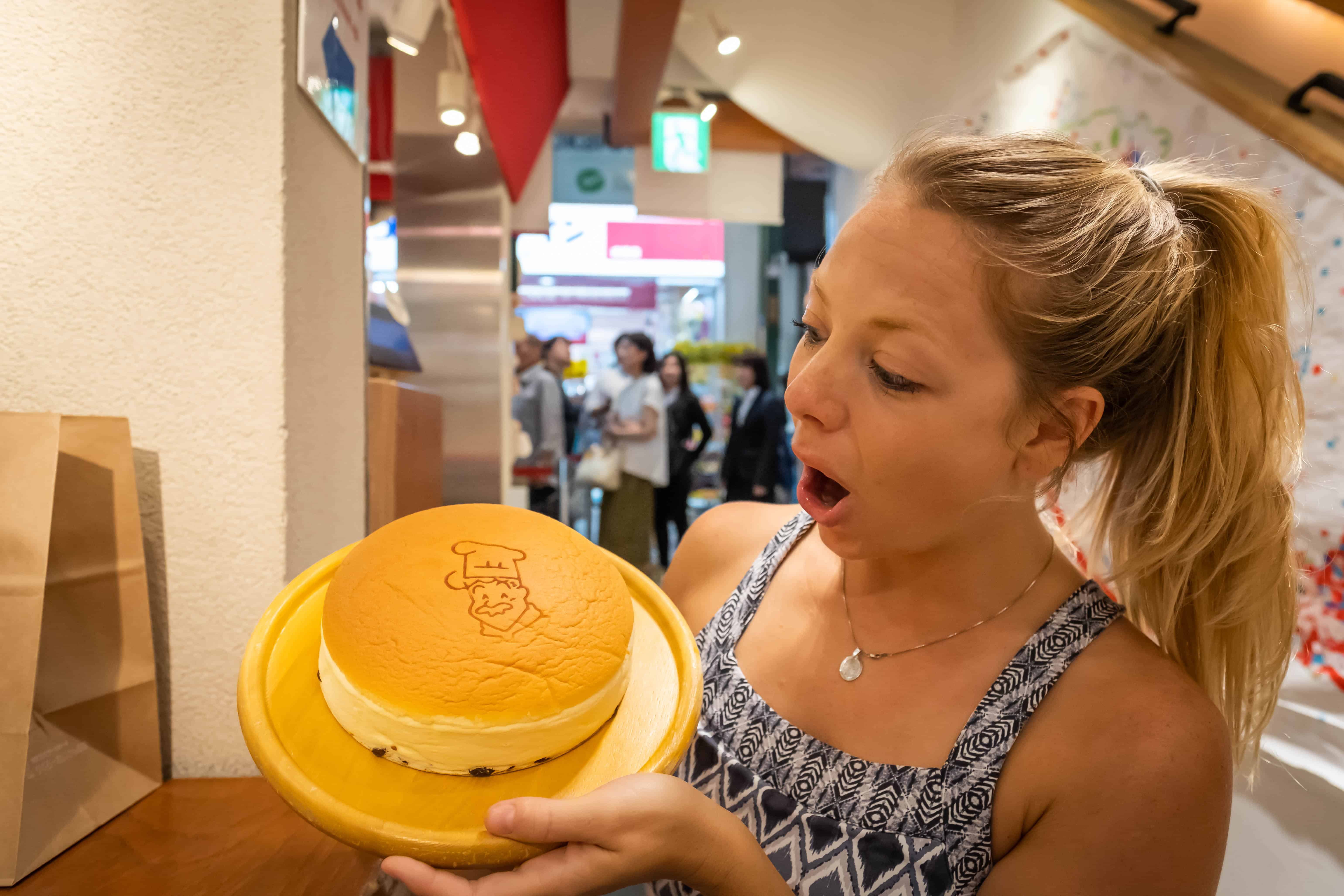
Another famous dish in Osaka is Japanese jiggly cheesecake. Rikuro Ojisan no Mise is a small shop that sells hot and fresh cheesecakes all day! Come with friends, you can only buy a whole cheesecake, not by the slice.
You’ll likely have to wait in line to buy a cheesecake fresh out of the oven, but if you prefer not to wait, you can also go into the shop and buy one made earlier in the day. We got lucky and only had to wait five minutes in the line, but we were told it gets much busier depending on the day. A Jiggly cheesecake will set you back ¥700, but it is more than worth it! Plus, they keep well if you have a refrigerator in your hotel room.
Japan Travel Planning Resources
- Packing Guide—Check out our Japan Packing List to help you pack your bags and ensure you leave nothing at home.
- Protect Your Trip — We don’t travel without travel insurance, nor should you. You never know what can happen while traveling, so it’s best to be prepared. HeyMondo provides excellent short-term and long-term travel insurance plans.
- Travel Adapter – Find a good adapter to keep your electronics charged. Otherwise, you may be paying for a cheap one once you land. Purchase one here.
- Book an Experience – See all the best experiences and tours in Japan here.
- Get a Japan Rail Pass (Buy Here) – They make traveling around Japan much easier and cheaper.
- Travel Shoes – Allbirds are the ultimate travel shoe. They are sustainable and last forever while looking good.

